Harry Winston Opus Series: A Complete Overview From Opus 1 To Opus 14
At Time to Move in 2019, Dr. Nayla Hayek quietly let it be known that the Opus series would be continuing.
Since June of 2010, Hayek has been the chair of the Swatch Group’s board of directors. She became CEO of Harry Winston in January 2013 after Swatch Group acquired the brand.
Following the Swatch Group’s takeover, a continuation of the Opus series seemed in doubt to me, though in an interview at Baselworld 2014, Marc Hayek did reveal that he and his family loved the Opus series and that he foresaw a continuation.
Though seeing is believing, just the glimmer of hope provided by this information is a great reason to take a look back at the history-making timepieces of the Opus series, which remain the best-known and most important horological output of what was previously known as Harry Winston Rare Timepieces (and is now just Harry Winston).
And as you can probably guess, I absolutely love that the premise of the Opus series is its collaborative nature with some of the watch world’s leading independent watchmakers.
A “friendly” beginning
Like many good independent watchmaker stories in the modern era, this one also began with Maximilian Büsser. We know Büsser now as the founder of MB&F. However, before that, at the age of 31, he became the CEO of the burgeoning Harry Winston Rare Timepieces.
Büsser had energy, ideas, and a deep-seated passion for unusual haute horlogerie – traits he took with him when he founded his own company, MB&F (Maximilian Büsser & Friends) in 2005.
The idea of the “concept” watch is one that Büsser perfected for Harry Winston’s Opus series. The ultra-limited annual edition revolved around cooperating with an outstanding independent watchmaker each year to create a signature edition of timepieces. One aspect of the original idea was that the independents would gain from the larger public exposure that Harry Winston would generate, while the diamond-centric brand would gain serious horological kudos from associations with world-class watchmakers.
The watchmakers Harry Winston Rare Timepieces chose to work with all have had reputations for unusual and high-quality timepieces. Upon introducing each Opus, however, the independent watchmakers involved (many of which were practically unknown outside collectors’ circles) became known to a broader range of people suddenly interested in their products and cognizant of their names.
Hats off to Harry Winston for ringing in a more transparent attitude: while most companies – particularly in the early days of these cooperative masterpieces – kept the names of the makers of their movements for themselves, Harry Winston made it a point to proudly communicate the origins of each unique, collaborative Opus timepiece.
Even though the brand known primarily for its high-quality diamonds has had two new directors between Büsser’s departure and the Swatch Group takeover – Hamdi Chatti, now CEO of Louis Vuitton’s watch and jewelry division and Frédéric de Narp, who went on to become CEO of Bally group – the unique Opus series remained the highlight of the Harry Winston watch collection throughout and has played a significant role in advancing the brand’s horological reputation.
I am quite excited that the series is set to continue and eagerly look forward to the launch of Opus 14 – whenever that may be.
Opus 1
Kicking off the Opus series in 2001 following a chance encounter with his friend Büsser on an escalator at Baselworld was François-Paul Journe, who at the time was focusing most of his energies on the physical phenomenon of resonance. Resonance, in a nutshell, is the synchronization of frequencies.
It is this type of movement that Journe utilized for his joint project with Harry Winston. Seemingly connected by an invisible wave, the dual balance wheels of this wristwatch’s two independent movements are designed to provide precision as well as the display of two independent time zones. The crown winds and sets both movements and both time zone displays. Six different versions were created, two of which were set with exquisite Harry Winston diamonds.
Another of Journe’s focuses at the time was the tourbillon, and thus another six unique Opus 1 models housed in platinum were created with a tourbillon and a remontoir d’égalité constant force escapement.
Journe created the final six Opus 1 models to be powered by the world’s first automatic movement outfitted with a five-day power reserve – this normal-sized caliber (30.5 mm in diameter and 5.7 mm high) achieved it with just one spring barrel.
Quick Facts Opus One (chronometer version)
Case: 38 mm, platinum, (alternatively set with 51 baguette-cut diamonds weighing in at 4.85 ct)
Movement: manually wound movement with two independent resonance-controlled gear trains, escapements, and balances
Functions: time displays (hours, minutes, seconds) for two time zones; power reserve indication (42 hours)
Limitation: 6 pieces of the chronometer version described here, each one unique in some way; six tourbillon editions; six versions with five-day power reserve
Price: most recent auction hammer price was $176,147 (Christie’s Important Watches Hong Kong, June 2015)
Opus 2
While the Opus 1 paid homage to the scientific side of watchmaking, the Opus 2 certainly embodied its beating heart.
Antoine Preziuso, a native Genevan with Italian parentage, works by his own admission chiefly on inspiration. And the story of how this timepiece came to be is indicative of that: the lauded series’ second artist was contracted to create a classic tourbillon for Harry Winston’s freshly founded timepiece division. When he arrived at the factory to present the finished product, he was wearing another model of his making. Its white gold dial was embellished with a hand-engraved rendering of the arched entrance to the firm’s Fifth Avenue store. This made such an impression on Büsser that he became a natural choice for the next installment.
Büsser and Preziuso conceived a double-faced, “back-to-back” timepiece featuring a tourbillon on the front and a full perpetual calendar on the back, the latter only revealed by opening a hinged cover.
Preziuso created 23 unique, limited timepieces in his workshop for the Opus project. Eleven of these constitute the back-to-back tourbillon and perpetual calendar model; eleven are outfitted only with the tourbillon; and one lucky owner was able to purchase a tourbillon model featuring a skeletonized movement whose beveled and polished bridges were set with 158 brilliant-cut and 16 baguette-cut diamonds. The 38 mm case of the latter was also set with 62 baguette-cut diamonds.
Quick Facts Opus Two (tourbillon version)
Case: 38 mm, platinum, swiveling case so either side can be worn face up
Movement: manually wound skeletonized movement with mysterious winding and one-minute tourbillon and 110 hours of power reserve
Functions: hours, minutes
Limitation: 11 pieces of the version described here; 24 pieces total of the Opus 2
Price: most recent auction hammer price was $378,199 (Christie’s Important Watches Hong Kong, June 2015)
Opus 3
In bringing the Opus 3 to fruition, Ronald Winston’s express goal was to continue the pioneering role for the firm his father founded – to live on the creative edge, so to speak. Winston has often said, “For a timepiece to bear the Harry Winston name, it has to be exceptional.” And the company took quite a risk with the exceptional Opus 3.
Parisian-born Vianney Halter’s 1999 Antiqua model is one that breaks many conventions in watchmaking. Büsser took one look at it and fell in love.
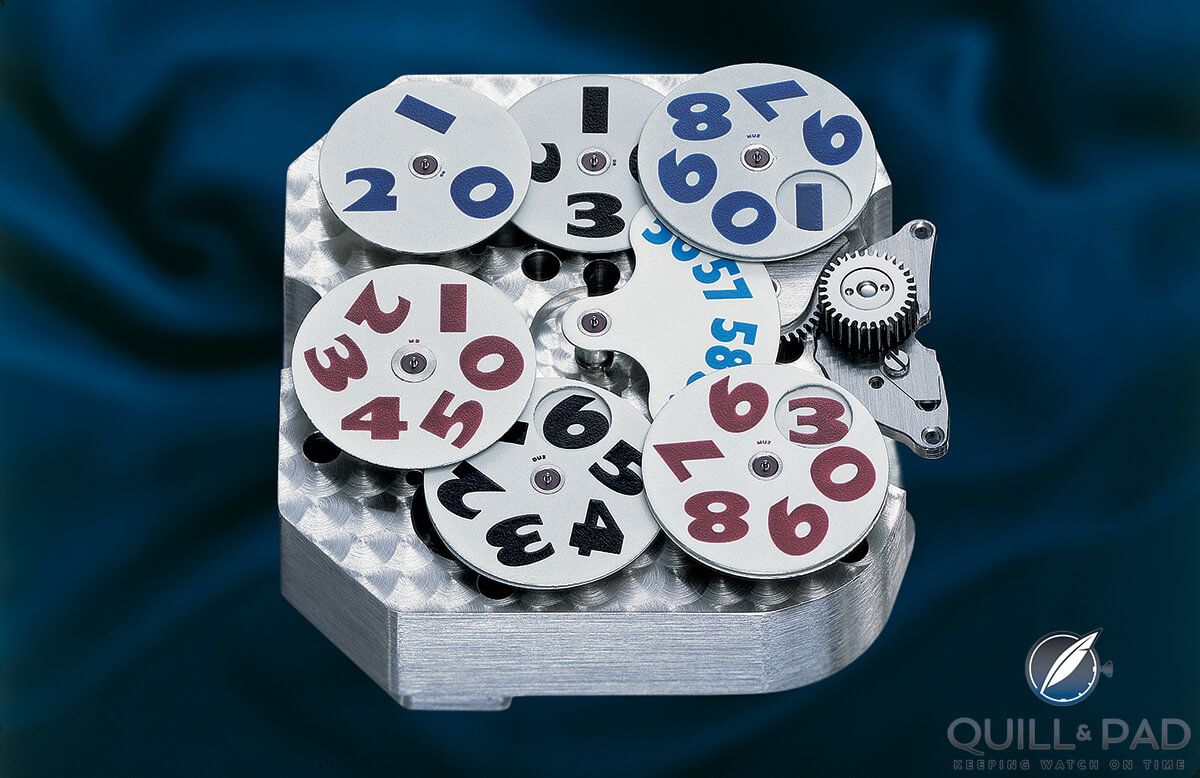
Multiple overlapping discs are required for the digital displays of the Harry Winston Opus 3 by Vianney Halter
The equally non-conformist Opus 3 does “nothing more” than display hours, minutes, seconds, and date: ten little disks incorporated into the movement’s German silver base plate show these indications, including jump hours and a countdown of the final four seconds before the current minute jumps to the next. To make all this technically possible, the 53-jewel movement contains two separate gear trains and twin spring barrels. The horizontal notched crown incorporates four setting positions as well as a winding position.
The Opus 3 constituted a deliberate break with Harry Winston’s usual modern, yet understated, way of designing its products. This timepiece was not necessarily conceived to be timeless, though it has certainly become legendary thanks to its long road to maturity and the – finally perfected – groundbreaking mechanics.
Only in 2010 did Harry Winston begin delivery of this timepiece, thanks in part to Frédéric Garinaud (who went on to develop the Opus 8) when he was still at Renaud et Papi.
Quick Facts Opus Three
Case: 36 x 52.5 x 13.7 mm, platinum or pink gold (25 pieces each), 5 pieces in platinum set with baguette- and brilliant-cut diamonds (4.44 ct)
Movement: manually wound movement with two separate gear trains and twin spring barrels
Functions: digital display of hours, minutes (countdown of last four seconds to jump), seconds; date (countdown of last four seconds to jump), day/night indication
Limitation: 55 pieces
Price: original retail price $80,000; most recent auction hammer price was $238,317 (Christie’s Important Watches Hong Kong, June 2015)
Opus 4
Heading back into “known” territory, Harry Winston entered a more traditional cooperative state with Christophe Claret, who was already working collaboratively in the background on other complicated timepieces such as the Histoire de Tourbillon. Unlike all the other independents that Harry Winston has worked with on the Opus adventure, Claret owned a mid-sized company employing close to 100 technicians, watchmakers, and artisans. The other collaborative watchmakers maintained much smaller workshops.
As Claret’s specialty is the minute repeater, the Opus 4 naturally features an unforgettable example with cathedral gongs – and more: it is displayed together with a manually wound tourbillon on the front, while the back comprises a strikingly large moon phase display with date. To top it all off, the limited edition timepiece with a 53-hour power reserve is housed in a completely reversible case so its owner can wear the timepiece either way up as the mood strikes. Eighteen were completed in 44 mm platinum cases, while two unique pieces were offered set with baguette- or princess-cut diamonds.
Quick Facts Opus Four
Case: 44 mm, platinum, swiveling case so either side can be worn face up (hours and minutes are shown on both sides)
Movement: manually wound movement with one-minute tourbillon and 53 hours power reserve
Functions: hours, minutes (shown on both back and front), seconds; date; moon phase display; minute repeater (cathedral gong)
Limitation: 18 pieces in platinum and two pieces set with baguette- or princess-cut diamonds for a total of 20 pieces
Opus 5 / Opus V
The 2005 edition of the Opus led Harry Winston back into the quasi-science fiction realm that began with Halter’s Opus 3. Cooperating with one-half of the duo known as Urwerk, Harry Winston and Felix Baumgartner presented a satellite hour watch reminiscent of the novel timepieces that Urwerk produces.
The secret of this watch display lies in three small cubes arranged like satellites that turn and rotate as needed to show the current hour. The numeral currently in use is found at the long end of an arrow that points to the minutes on a scale arched along the left side of the case.
Two major elements can also be found on the back of the case: an integrated service indicator to let the wearer know when it is time send the watch in for maintenance and a fine adjustment screw that the wearer can use to adjust the rate by plus or minus thirty seconds.
Quick Facts Opus Five
Case: 50 mm, pink gold, platinum
Movement: manually wound movement with 122 hours power reserve
Functions: hours (satellite), minutes (retrograde) on front; power reserve indication, day/night indication, five-year service indication on back
Limitation: 45 pieces (pink gold), 45 pieces (platinum), 7 pieces in platinum set with diamonds, 3 pieces in platinum set with baguette-cut diamonds for 100 total pieces
Price: most recent auction hammer price was $253,859 (Christie’s Important Watches Hong Kong, June 2015)
Opus 6
Though Büsser resigned from Harry Winston in 2005 to start MB&F, his successor Hamdi Chatti decided to continue the successful series of unique collector’s watches.
Opus 6 was created with French-English tourbillon specialists Greubel Forsey, at the time a small independent brand making a name for itself with complicated, ultra-luxurious timepieces.
What Robert Greubel has termed “a beautiful adventure” is in reality a watch the duo outfitted with a mechanism they named the Emotion 30°. This was a version of the tourbillon movement inclined by thirty degrees that these watchmaker-inventors had long been experimenting with, and it made the Opus 6’s visuals seem more like a horological ballet choreographed for its wearer than a tangible timepiece. Though it was naturally the latter as well.
Translating complexity into mechanical beauty, the Opus 6 was available in an extremely limited edition of only six pieces – not unlike Greubel Forsey’s own output: only about 100 lucky collectors can call a Greubel Forsey their own each year. And in 2006, Greubel Forsey was only making perhaps 30 timepieces annually.
Quick Facts Opus Six
Case: 46 mm, white gold
Movement: manually wound Emotion 30° movement with two tourbillons (the larger tourbillon revolves in 4 minutes; the smaller tourbillon inside it at a speed of one revolution in one minute) inclined at 30° with 72 hours of power reserve
Functions: hours (disc), minutes (disc), seconds (disc)
Limitation: 6 pieces
Price: most recent auction hammer price was $375,313 (Christie’s Important Watches Hong Kong, May 2012)
Opus 7
Lucky number seven was Andreas Strehler’s venture into Harry Winston’s world. An independent movement designer watch fans may remember from his work with Chronoswiss’s Chronoscope and Moser’s first Perpetual Calendar, Strehler worked on his Opus under the motto, “It’s complicated to be simple.”
What emerged was an unprecedented timepiece with an alternating display showing either hours and minutes or a power reserve indicator. All the wearer has to do is press the crown to transform the display.
Strehler’s love of historical artistic movements of Art Nouveau and Art Deco inspiration are apparent in the butterfly-shaped bridges of the simple movement – like his own Papillon. Fortunately, this movement is almost entirely visible as it practically envelops the small dial inside its 45 mm white gold case. The Opus 7 was a limited edition of 50 pieces.
Quick Facts Opus Seven
Case: 45 mm, white gold
Movement: manually wound movement with butterfly-shaped skeletonized bridges that can transform the indication shown by pressing a button
Functions: hours, minutes; power reserve indication
Limitation: 50 pieces
Price: most recent auction hammer price was $176,147 (Christie’s Important Watches Hong Kong, June 2015)
Opus 8
Frédéric Garinaud had an idea: a hybrid timepiece that would bring together complicated mechanics and digital electronics. Chatti, however, upon meeting with Garinaud in early 2007 presented him with a new challenge: why not transform the hybrid display into a digital display? So what Garinaud and his CSH (Cellule des Spécialités Horlogères) basically created was a complicated hand-wound mechanical timepiece with the look of circuit-controlled quartz.
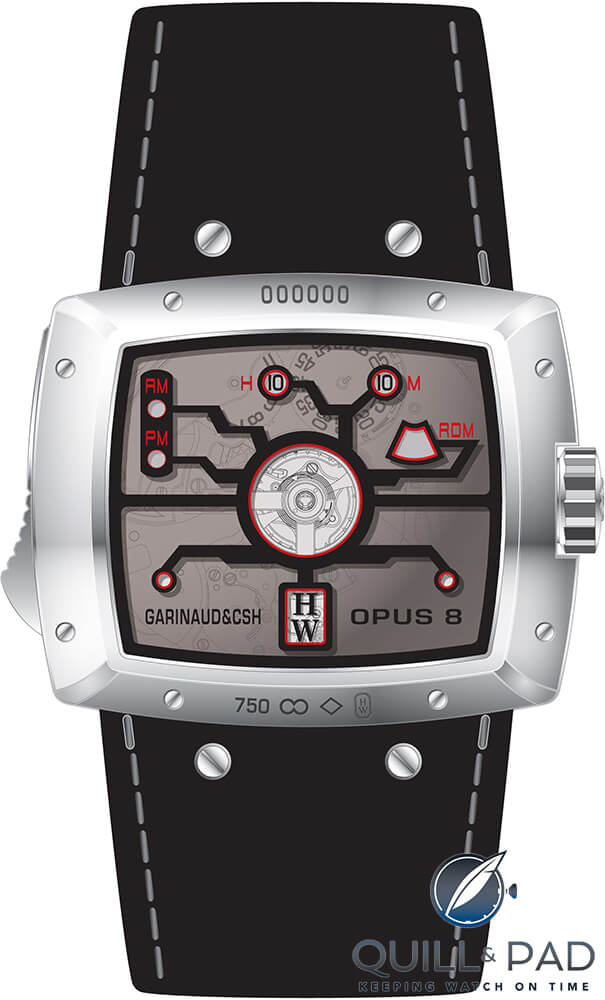
The back of the Harry Winston Opus 8 by Frédéric Garinaud; the printed “circuit” is just for decoration
Forty-four jewels and 437 components attest to its complexity as do functions such as digital hour (am/pm) and minute displays (in segments of five minutes) on the front and a second time zone shown by disc (am/pm hour and five-minute segments) as well as a power reserve indication on the back.
Launched just before the great economic crash of 2008, this one was probably not the most popular Opus timepiece, but it certainly sparked a great deal of conversation at its introduction.
Quick Facts Opus Eight
Case: 45.8 x 33.5 mm, white gold
Movement: manually wound movement with digital display module and 48 hours power reserve comprising 437 components
Functions: digital hours and minutes (shown in 5-minute increments); am/pm indication; power reserve display on back
Limitation: 50 pieces
Opus 9
An Opus as different from the others as day is to night, the ninth in the series was created by watchmaker Jean-Marc Wiederrecht and designer Eric Giroud – a duo that often continues to work with Büsser as well.
On the basis of a hand-wound Frédéric Piguet movement, Wiederrecht created two powerful chains set with Harry Winston gemstones to show the hours and the minutes in linear fashion – the chain on the right set with baguette-cut diamonds and a single garnet displays the hours, while the chain on the left set with the same constellation of precious stones displays the minutes. The effect is as clean as a regulator.
Giroud packed this innovation in an interesting and lavish white gold case enveloped in curved sapphire crystal.
At the 2009 edition of the Grand Prix d’Horlogerie de Genève, this watch took home the “design watch” prize.
Quick Facts Opus Nine
Case: 56 x 48 x 20 mm, white gold
Movement: automatic Frédéric Piguet base movement greatly modified by Wiederrecht with 72 hours power reserve
Functions: linear hour and minutes
Limitation: 100 pieces
Price: most recent auction hammer price was $145,063 (Christie’s Important Watches Hong Kong, June 2015)
Opus 10 / Opus X
The tenth anniversary of Harry Winston’s Opus series was celebrated by a collaboration with a watchmaker whose name at the time was not yet common in the language of watchmaking: Jean-François Mojon and his company Chronode work behind the scenes as a complication developer.
Moreover, the Opus X was really a non-spectacular complication – until one sees it in action, that is.
Synchronized rotational motion of disks replaces the traditional fixed hands. Mounted on a revolving frame that completes one full rotation in a 24-hour period, each of the slightly inclined subdials (hours, minutes, seconds, second time zone/24-hour display) turns within its own sphere to ensure that orientation remains constant in any position.
Seeming almost like a microcosmical solar system, the hand-wound movement is outfitted with a planetary gear train: the displays are located on individual satellite gear wheels that “orbit” around a central wheel.
Quick Facts Opus Ten
Case: 46 mm, white gold
Movement: manually wound movement with 72 hours power reserve
Functions: hours, minutes, seconds mounted on a revolving platform; second time zone/24-hour display, linear power reserve indication on back
Limitation: 100 pieces
Price: most recent auction hammer price was $160,605 (Christie’s Important Watches Hong Kong, June 2015)
Opus 11
The Opus 11 was eagerly awaited: by this time the Opus was so institutionalized that it was common for collectors and real enthusiasts to run to the Harry Winston booth straight off upon arriving at Baselworld in order to see the next installment.
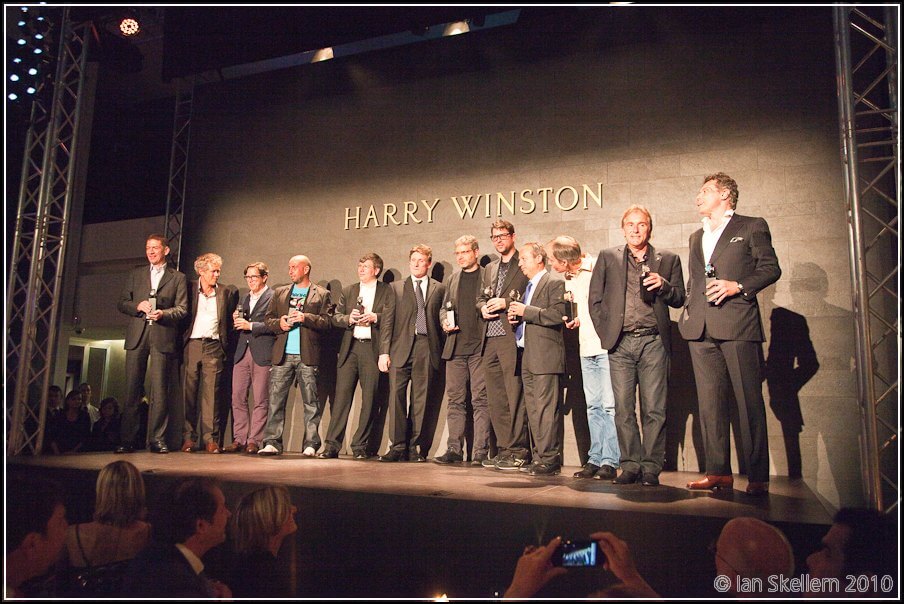
The Opus 1 to Opus 10 creators at the Harry Winston tenth anniversary celebration of the Opus series in Geneva
Additionally, Harry Winston had staged a large celebratory party at its Geneva factory in September 2010 celebrating a full decade of the Opus series. All of the watchmakers involved in the line were present as was Frédéric de Narp, various executives from Harry Winston, and the most important retailers and watch press in the world. The mood was truly celebratory, and I remember quipping at some point in the evening that if a terrorist had decided to blow that beautiful factory up on that day, it would have taken half the luxury watch industry with it!
The Opus 11, however, was unfortunately created under less of a fortunate star than the other timepieces in the series. Conceived by Denis Giguet, co-founder of MCT (and previous production manager at Harry Winston), it was a highly sensitive and complicated experiment with an enormous wow effect. In fact, when I saw it, I recall goosebumps tingling all over my own body.
Basically, the Opus 11’s function was to explode time at the top of the hour. This watch was slightly reminiscent of MCT’s own prism numerals in that they performed a special jump. But here the digital hour numeral literally exploded before settling back in to become the next hour’s numeral. Minutes were shown off to the side in a display that jutted out from the case, while the seemingly detached escapement took a place of pride in another display “bubble” just below it. The manually wound movement comprised 566 components, 155 of which were jewel bearings.
As I said, this breathtaking complication was a tad sensitive, though, and by the end of the fair the prototypes were already lagging. Then, just after the fair MCT basically imploded, and Giguet left the company.
As of right now, I feel that the Opus 11 could well become another Opus 3 – and hopefully it ends up with the same happy ending. In the wake of MCT’s ensuing sale, Harry Winston took the project in-house; it is my information that it is still being worked on. Most likely with the Swatch Group now in charge, this will take somewhat of a priority. I would love to see it in reliable action; it is truly a sight to behold.
Quick Facts Opus Eleven
Case: white gold
Movement: manually wound movement with extra-large titanium balance wheel comprising 566 components
Functions: jump hours, disc minutes
Limitation: 111 pieces (100 in white gold, 11 set with diamonds)
Price: price quoted at the time was $230,000
Opus 12
The advent of the Opus 12 was my first encounter with Emmanuel Bouchet. Now that I know him a little better, I am less surprised at the very clever Opus 12. But at the time I recall feeling a bit of awe at the ingenuity I held in my hands. Because Bouchet was really fully unknown at the time, I feel the Opus 12 never really got the recognition it deserved.
Basically, this beautiful timepiece comprises a jump hour function, but not a conventional jump hour. It is in fact a very elaborate retrograde set-up.
Rather than a pair of hands to show the time, the Opus 12 uses the hour markers as hands. At the top of the hour, the clever markers do a little dance that looks much like dominoes collapsing across the dial before settling into the current time display.
The minute hand moves markers once every five minutes; in between, the wearer can use the small central hand to read off the exact minute. This little display only lasts five minutes before the little hand flies back to the start in retrograde manner and the minute marker flips.
Two spring barrels exist within the clever movement: one to wind the movement and the other to wind the retrograde time display. The movement naturally also breaks a bit of tradition in that it experiments with a more modern style of finish, fully excluding anglage altogether. This lends it a resolutely modern look.
Quick Facts Opus Twelve
Case: 46 mm, white gold
Movement: manually wound movement with 72 hours power reserve
Functions: hours, minutes, seconds mounted on a revolving platform; second time zone/24-hour display, linear power reserve indication on back
Limitation: 100 pieces
Opus 13 / Opus XIII
Ludovic Ballouard was anything but a household name in 2013 – and the AHCI candidate is still relatively unknown to this day. Yet this technician hailing from France gave up his day job as one of François-Paul Journe’s leading watchmakers to strike out on his own in 2009, just as the world’s economic crisis was taking a foothold and luxury brands around him were crumbling. Still, he felt compelled to conceive and develop his own ideas and took the arduous route of the independent watchmaker.
The Opus 13 bases upon ideas he developed while making the two watches he has launched to date as an independent: Upside Down, whose numerals – except for the one displaying the current hour – are literally positioned upside down on the dial, and Half Time, whose numerals are cut in half (and thus rendered illegible) except the one showing the current hour.
This highly complicated Opus timepiece really has to be seen in action to understand as the most visible element is the outer minute ring, which needs a lot of energy to do its thing. The ring is directly driven by one of the movement’s two spring barrels: once each minute the ring changes the way it looks as one of the 59 pins marking off the minutes seems to jump out from nowhere to become visible. A magic trick that Ballouard has built into all of his watches.
The hours are indicated by a triangular hand that peeks out from behind a large crystal in the center. At midnight and noon a sliding shutter in the middle of the dial opens to reveal a “HW” logo.
Quick Facts Opus Thirteen
Case: 44.25 x 13.6 mm, white gold
Movement: manually wound Caliber HW4101 with 364 components (including 242 jewels!)
Functions: instantaneous jump hours displayed by 11 rotating hands; instantaneous minutes displayed by 59 hands; HW logo at center revealed at noon and midnight by sliding shutter
Limitation: 130 pieces
Price: approx. $300,000
Opus 14 / Opus XIV
The Swatch Group has shown no hesitation in taking on highly complex and original technical challenges, even in the face of continuing the highly popular and complex Opus series.
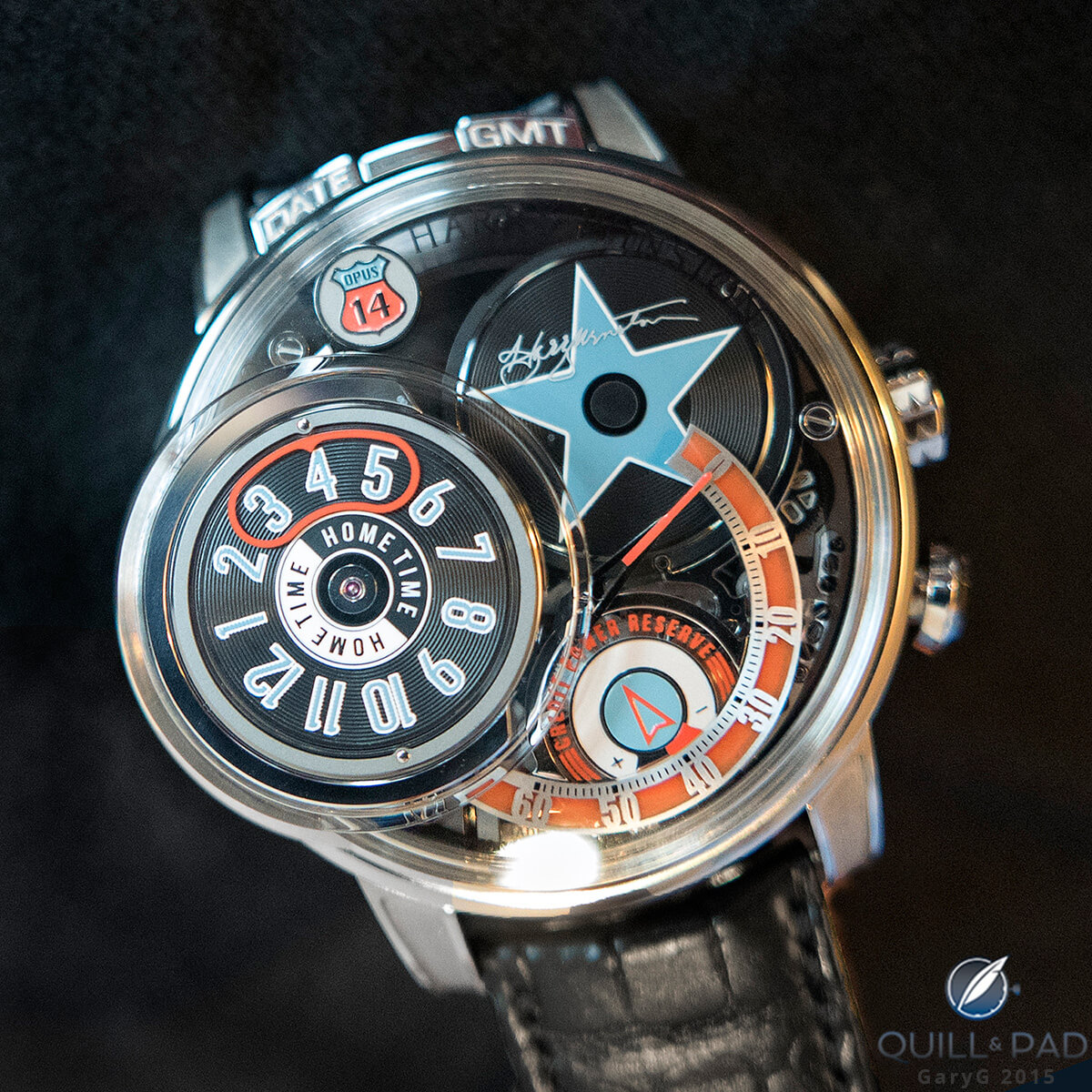
Harry Winston Opus 14
The Opus 14 was launched in November 2015 at a special event just for it, which already makes it much different as all the others were launched during Baselworld. But the 14 is also very different than all that has gone before it in its technology and feel.
Created by movement designers Franck Orny and Johnny Girardin, the watch was positioned as a jukebox-style automaton. This was accomplished by creatively adding to the movement a multi-disk stack that goes up and down like a tiny elevator in combination with a swing arm that moves three of the disks onto, and off of, a tiny turntable. The wearer engages with this using a selector lever.
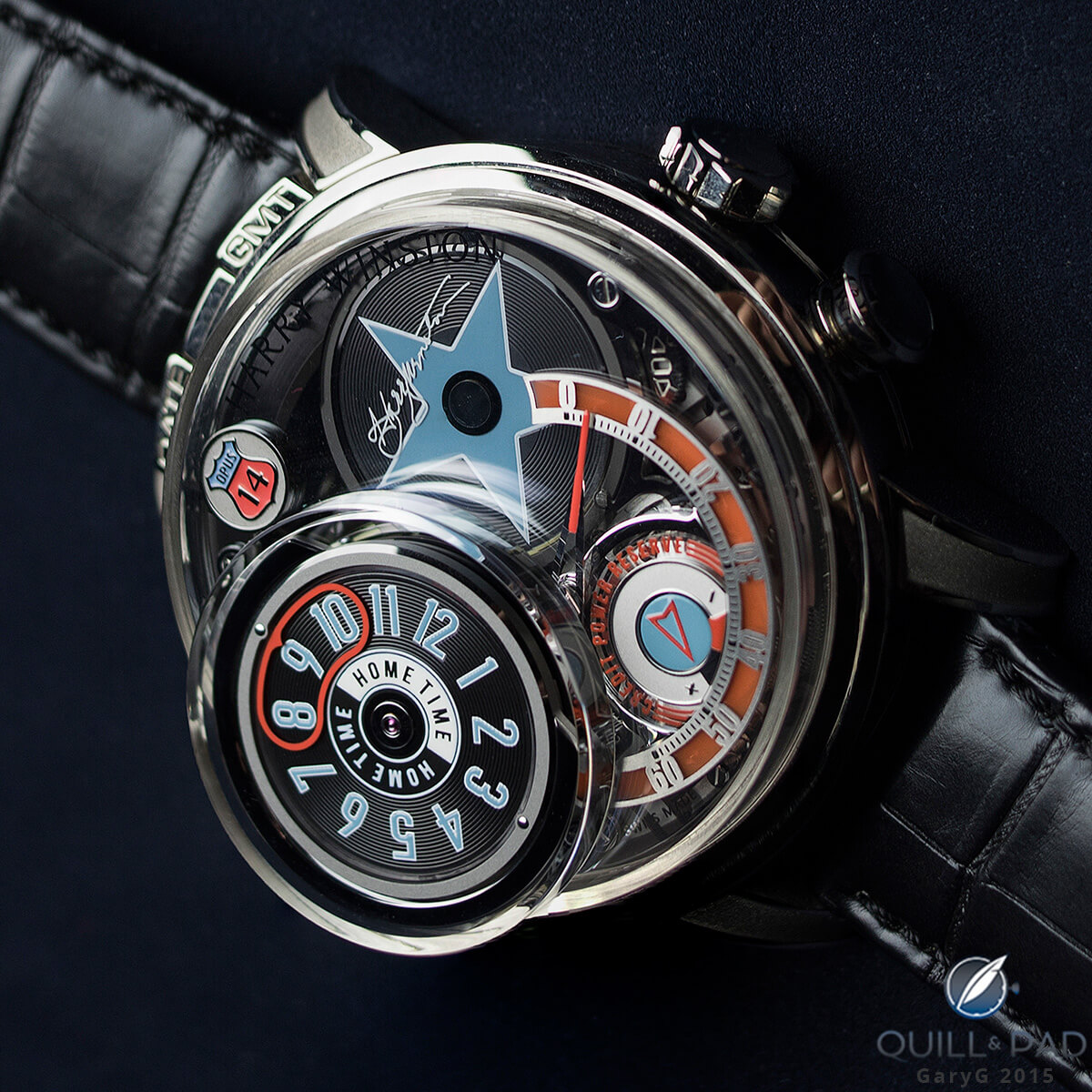
The Harry Winston Opus 14 showing its customizable aesthetic disk
The action is controlled by two turning rings; the outer engages the date disc when it is in place, and the inner ring connects with, and positions, the second time zone disc.
Two small indexing pins on each ring find indentations on the underside of the respective disc and engage, and then the turntable spins the disc into the proper position. You can also see the teeth on the outer edge of the turntable that engage with the pushers at the top of the watch to correct the date and GMT indications.
And now we have the Opus 15 to look forward to, though exactly when is anyone’s guess.
For more information, please visit www.harrywinston.com/opus-14.
Quick Facts Opus 14
Case: 54.7 x 21.9 mm, 18-karat white gold
Movement: manual winding Caliber HW4601, automaton complication, 68-hour power reserve, two spring barrels (main and animation), silicon balance
Functions: home time with hour and retrograde minutes; second time zone, date, automaton power reserve, main power reserve; GMT, date, customizable aesthetic disks positioned by swinging arm
Limitation: 50 pieces
Price: 428,000 Swiss francs
You may also enjoy:
The Urwerk Opus 5 For Harry Winston That Almost Was
Harry Winston Project Z13: Material Intent
Harry Winston Histoire De Tourbillon 5: Myth Or Reality?
Live Photos Of Harry Winston Opus 14 Plus Comments From Marc Hayek
Leave a Reply
Want to join the discussion?Feel free to contribute!


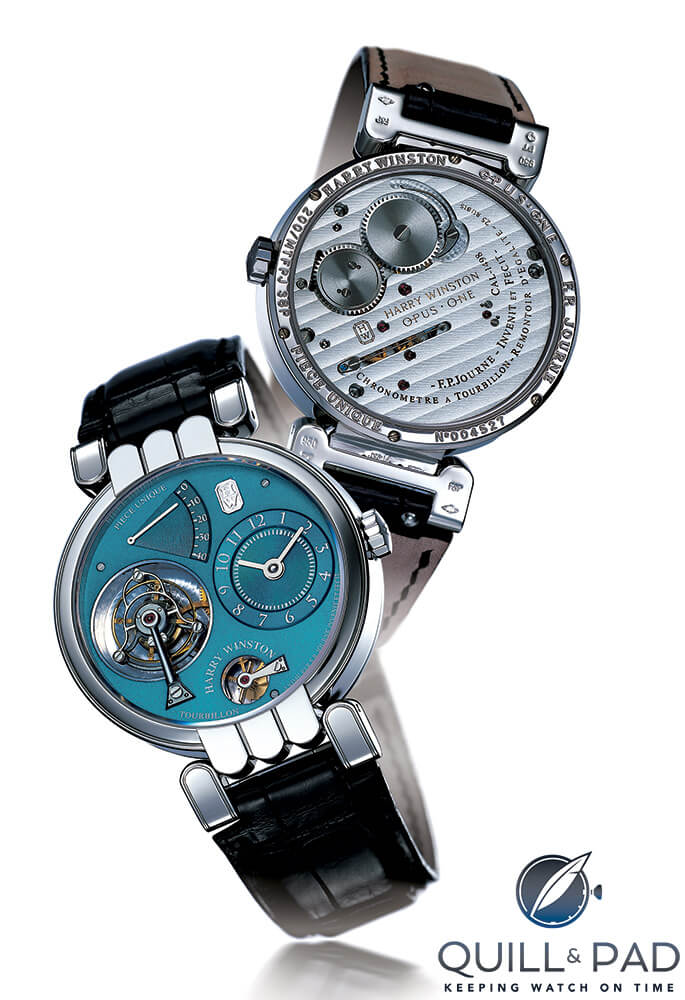
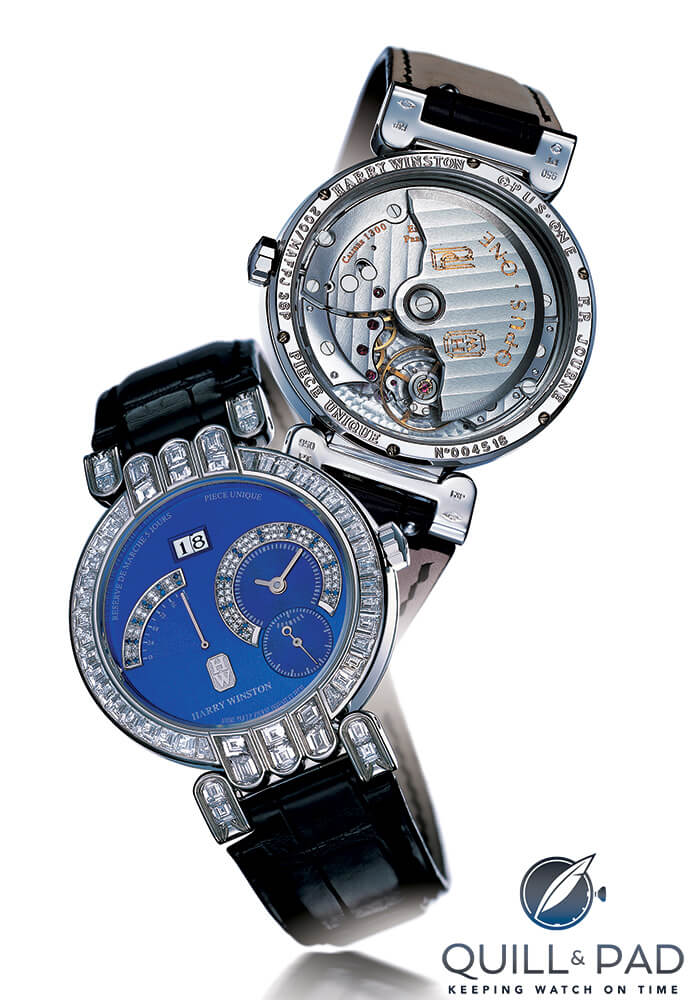
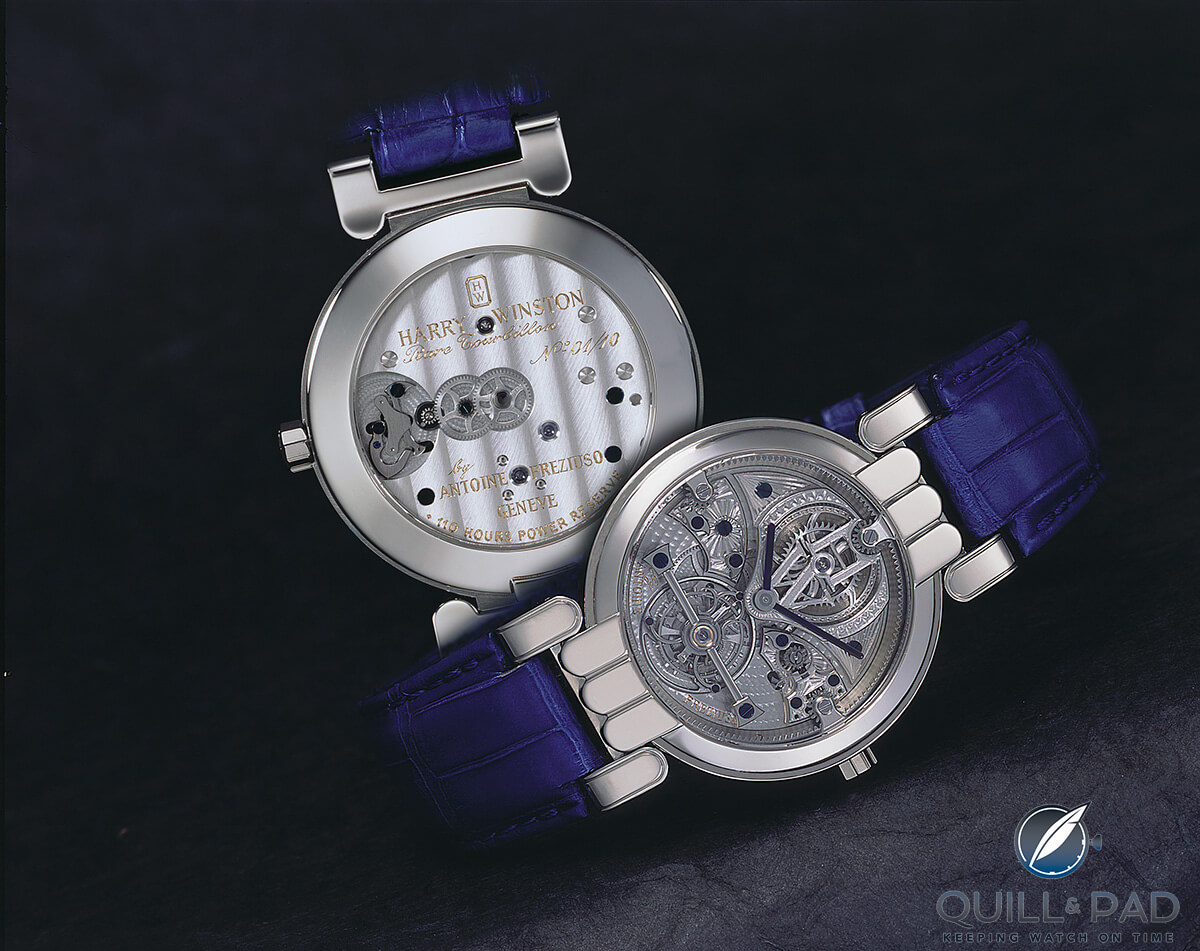
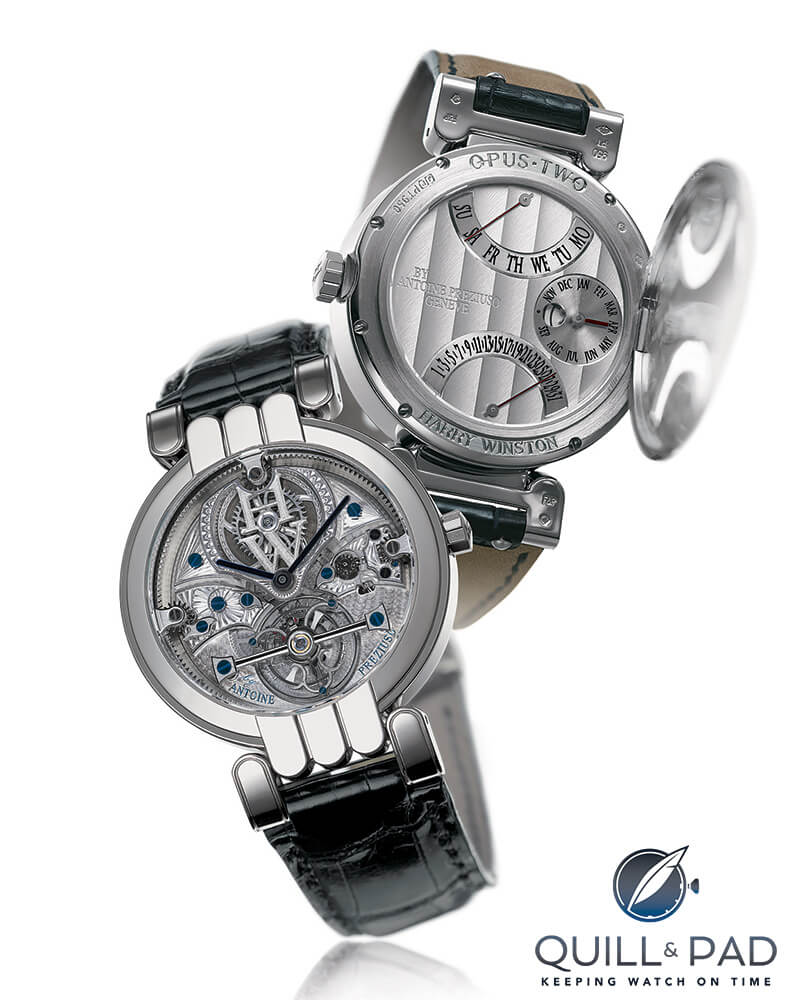
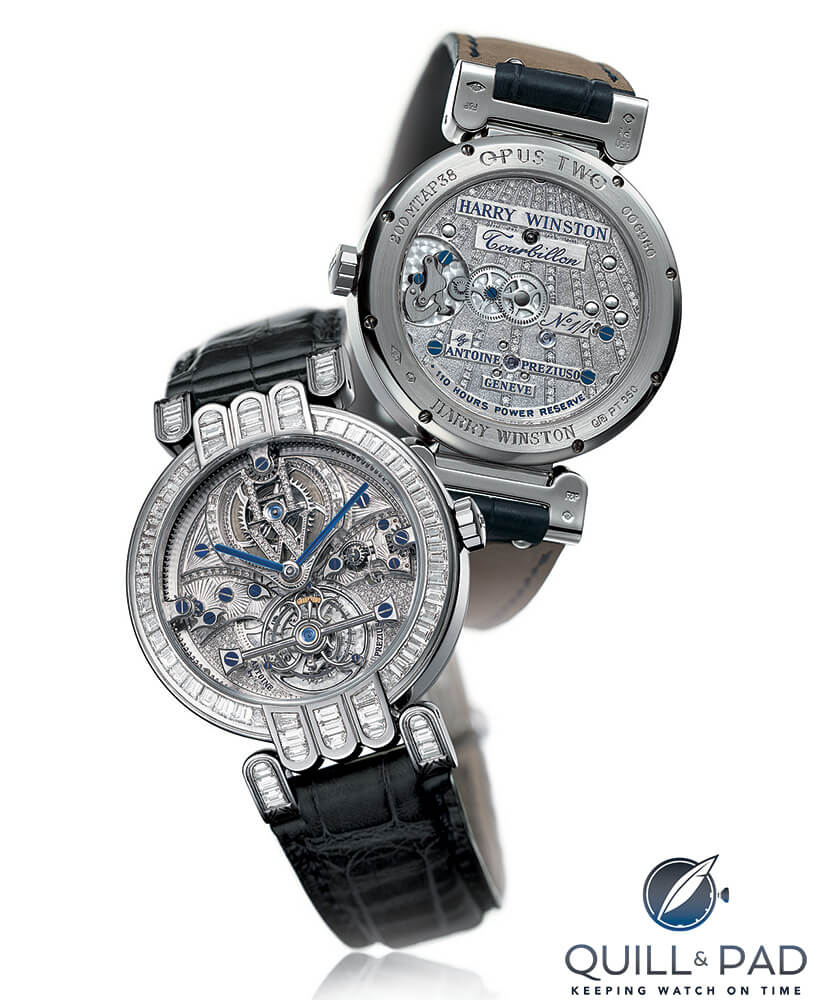
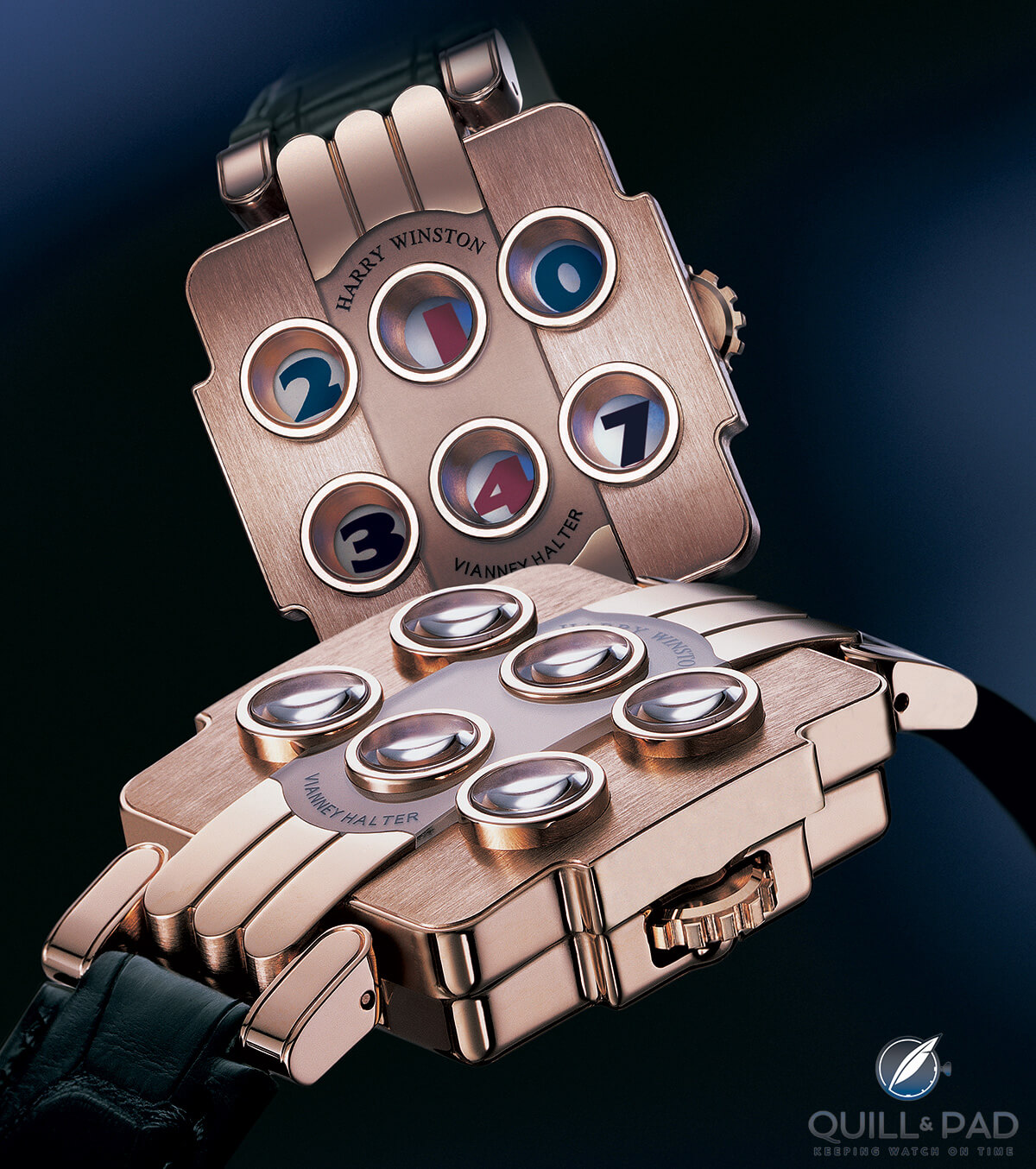
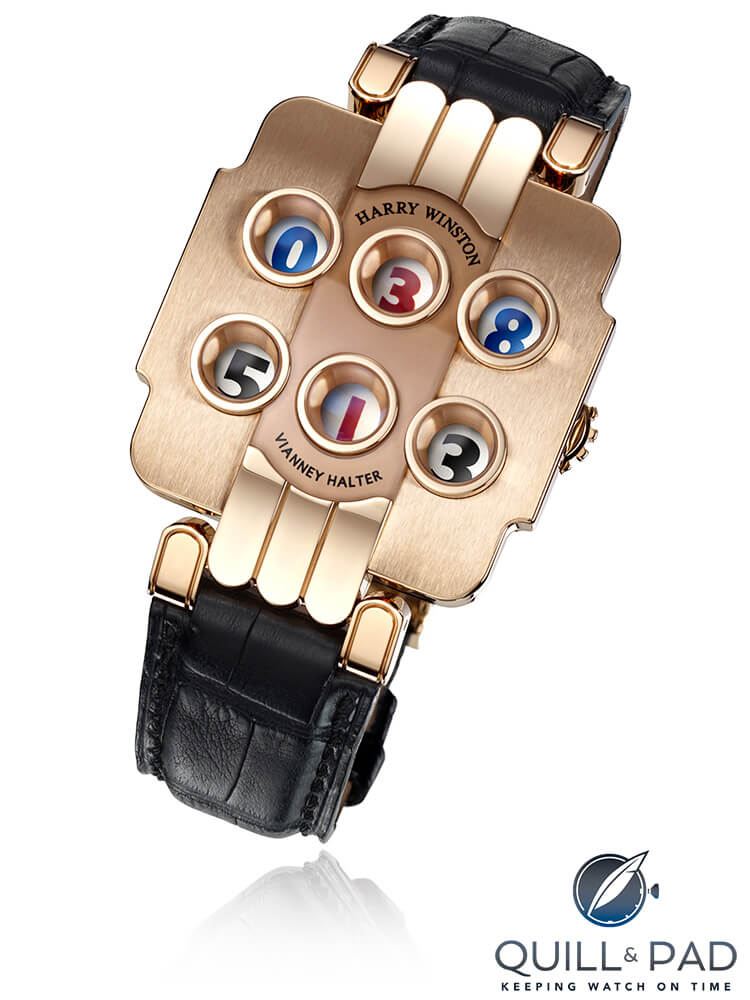
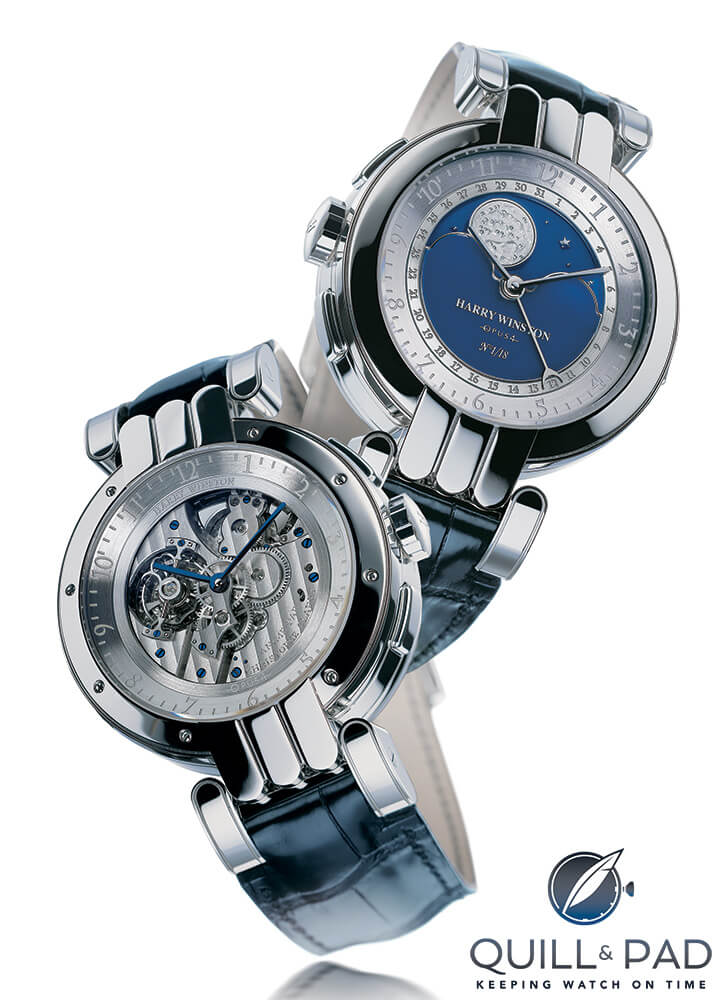
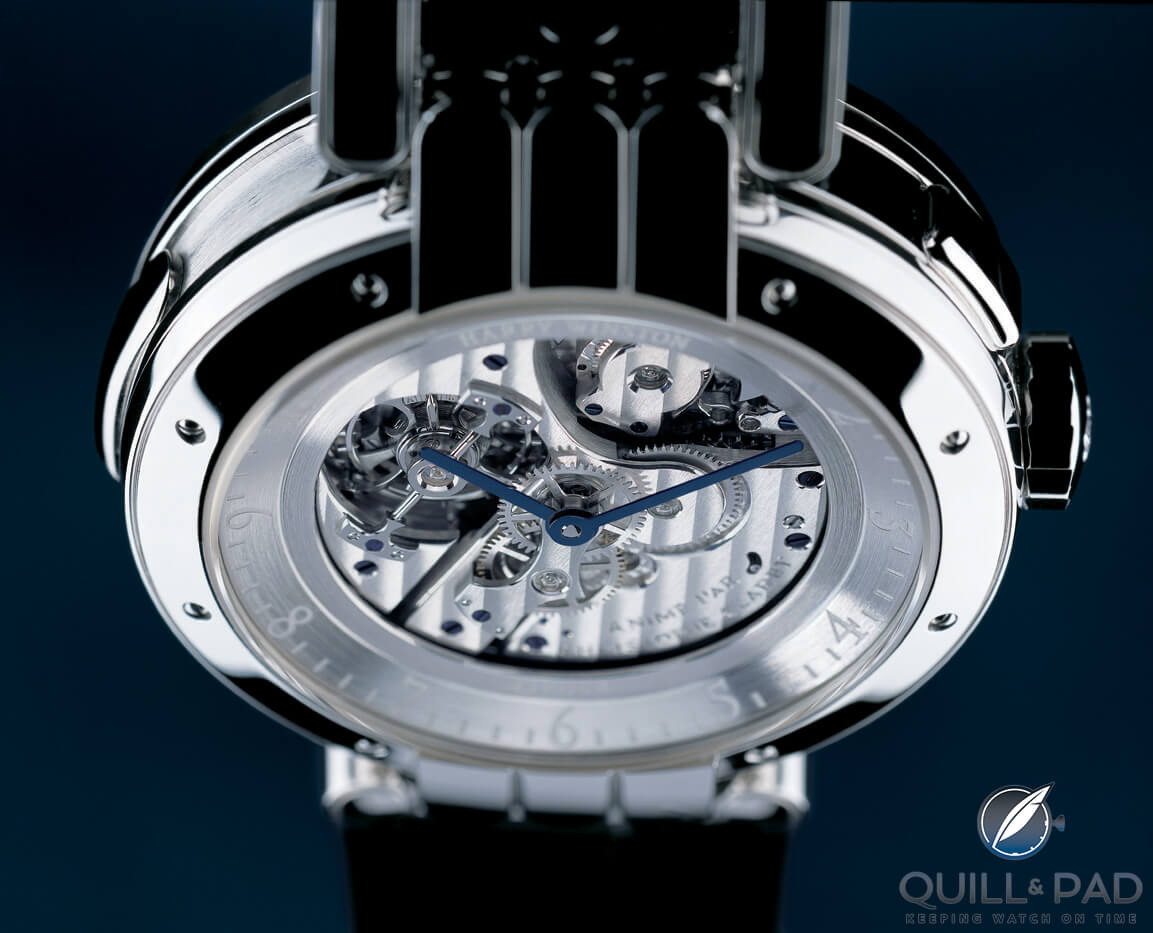
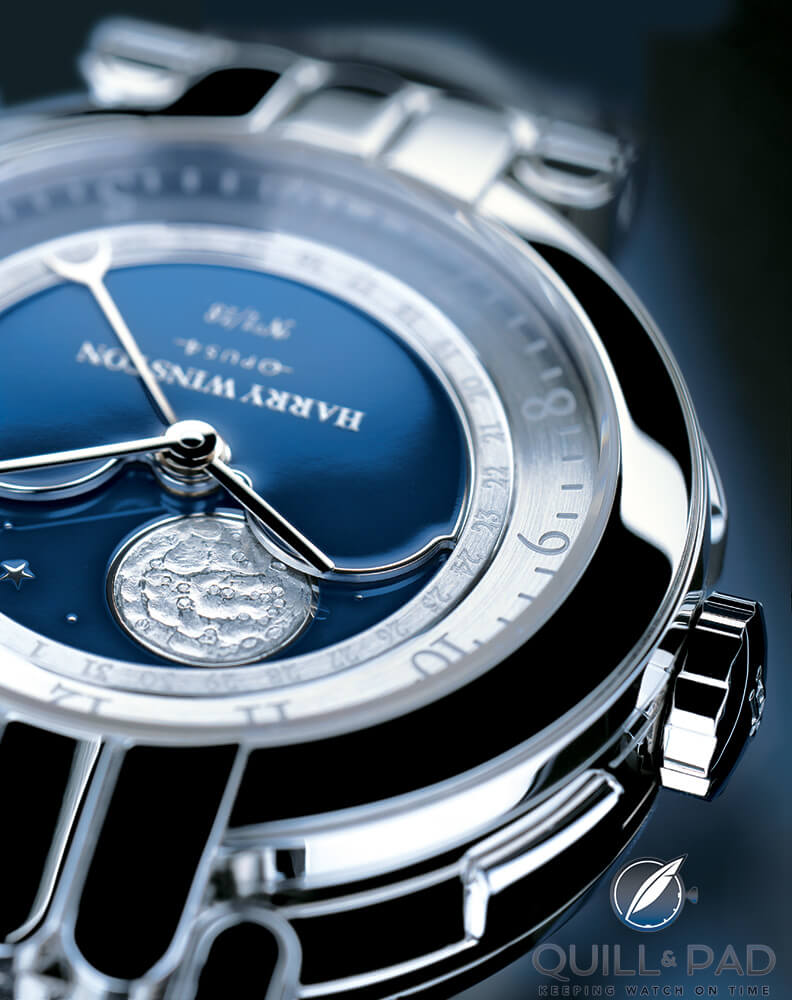
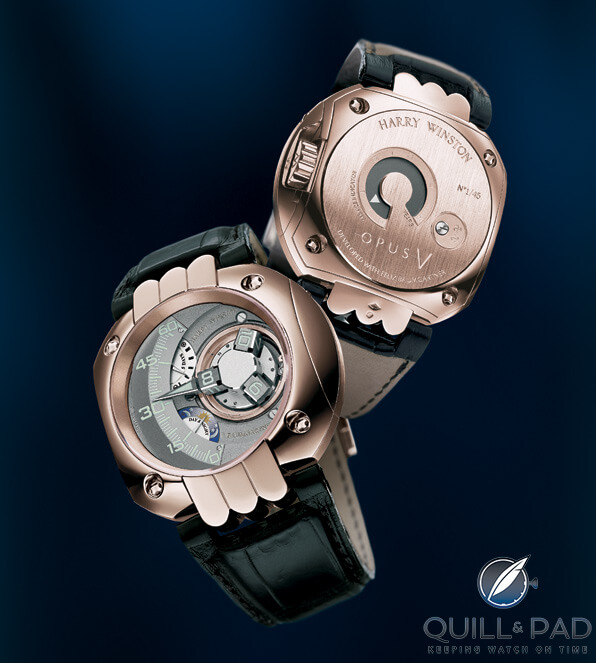
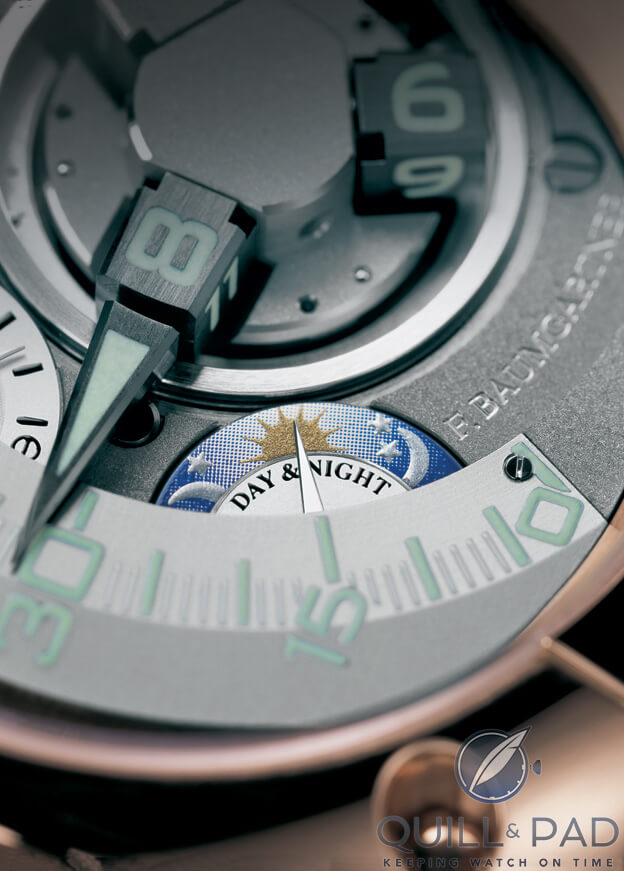
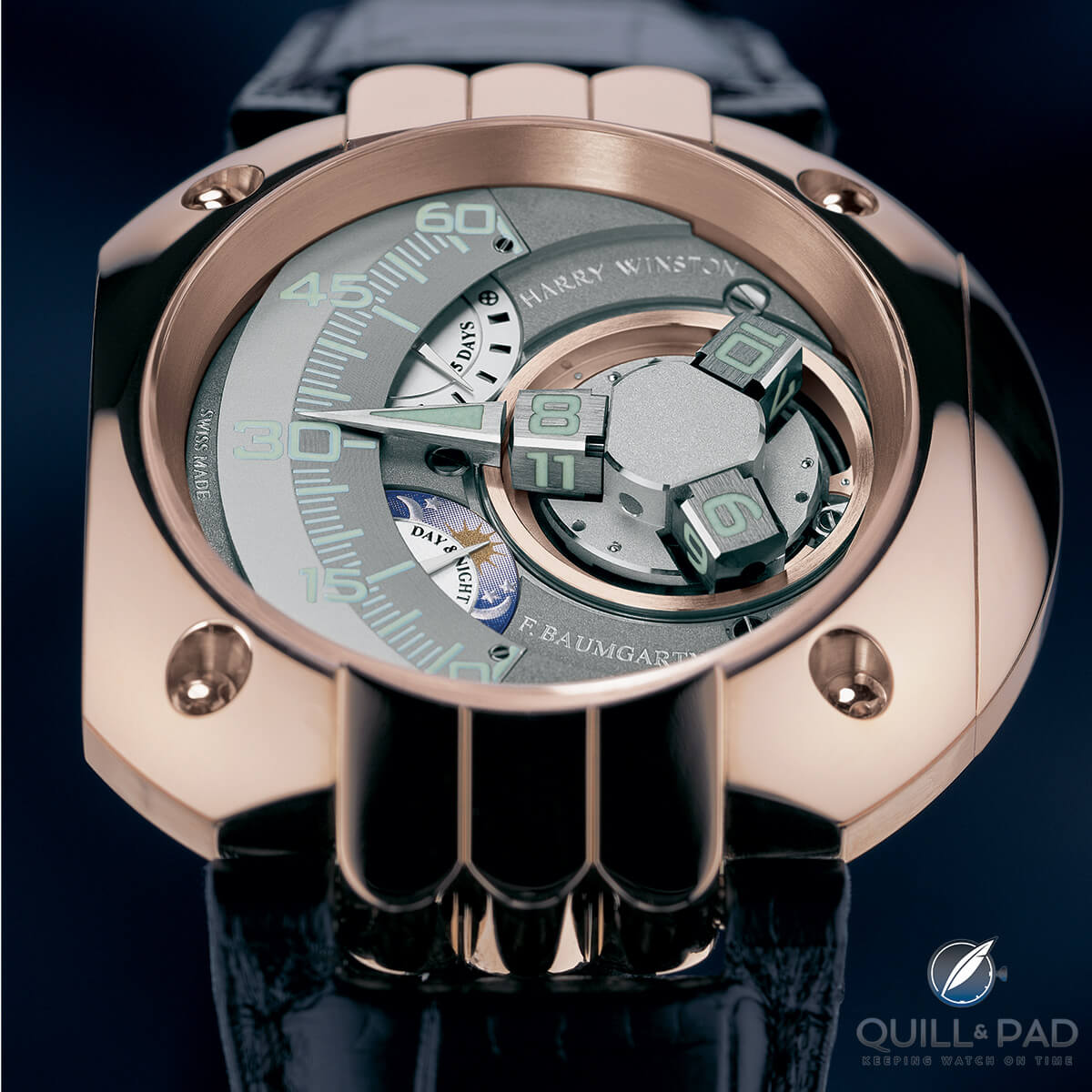
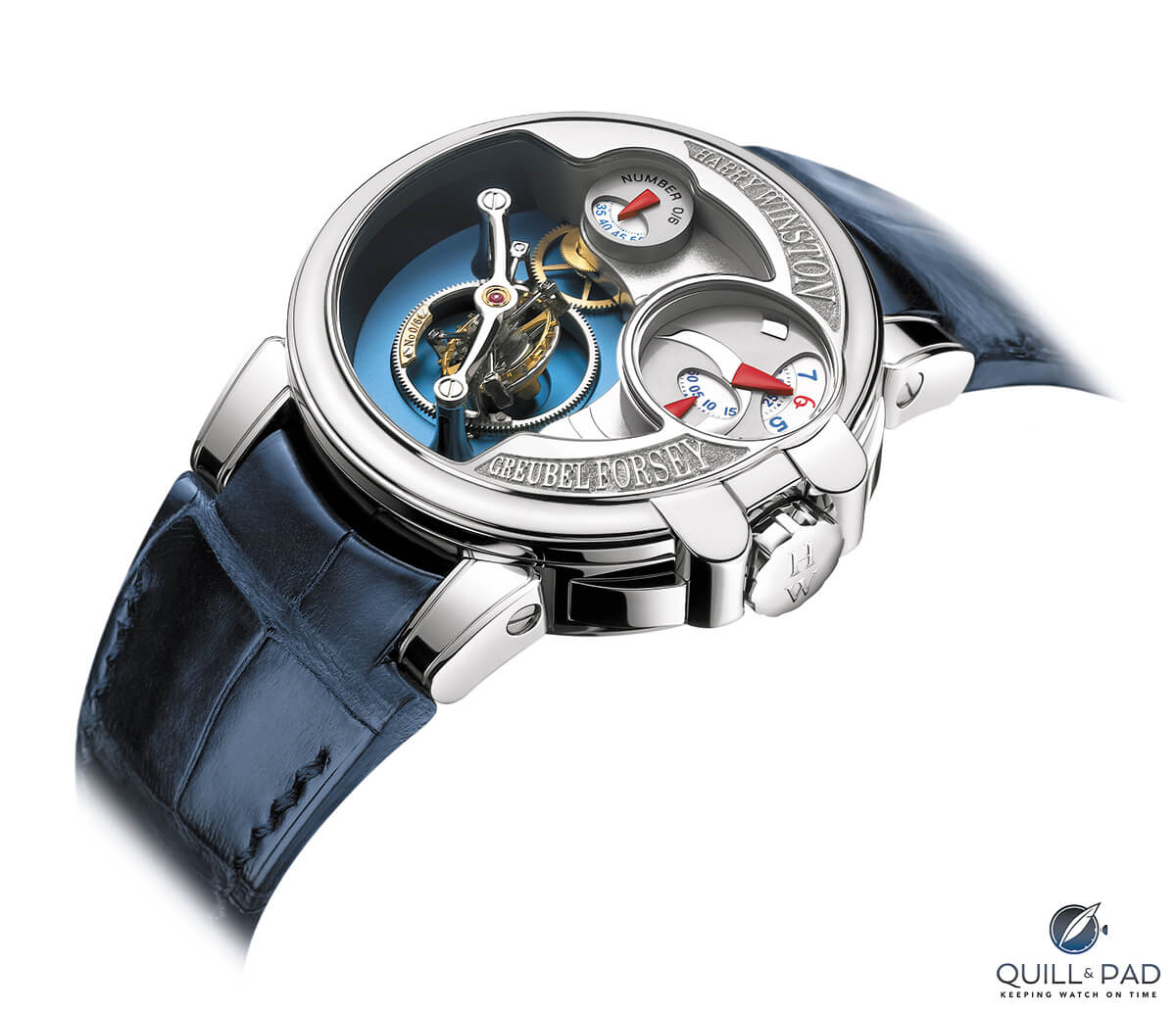
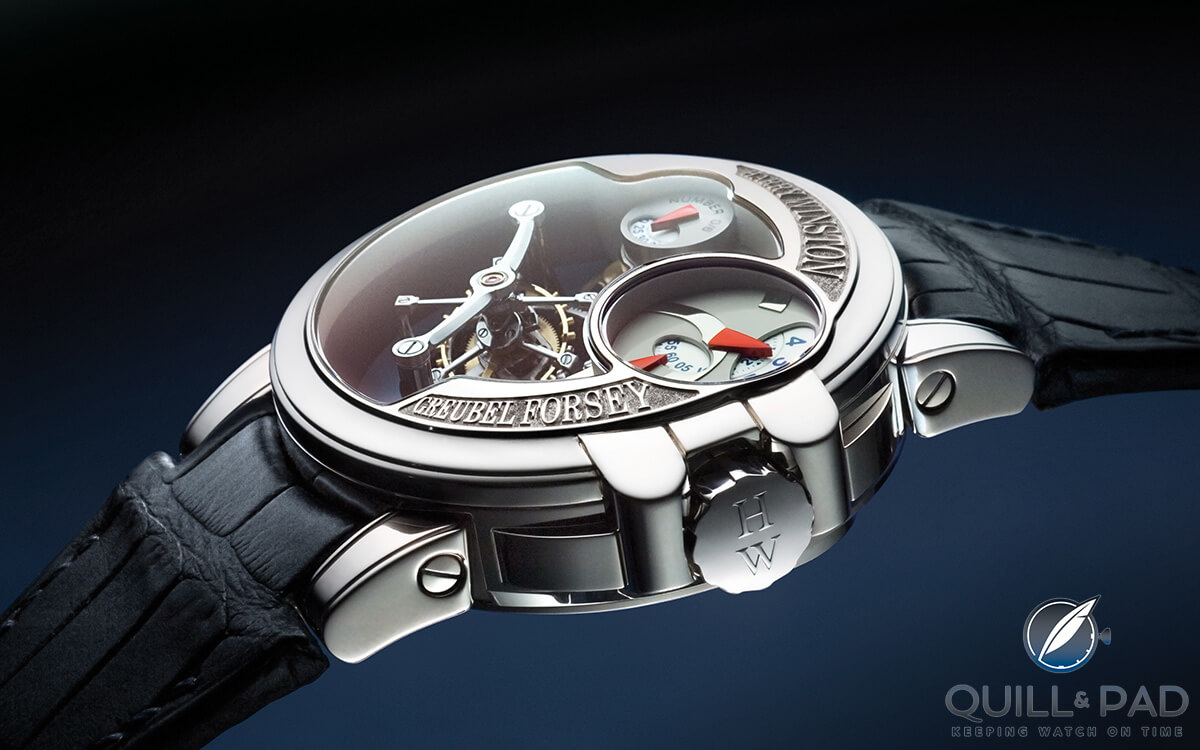
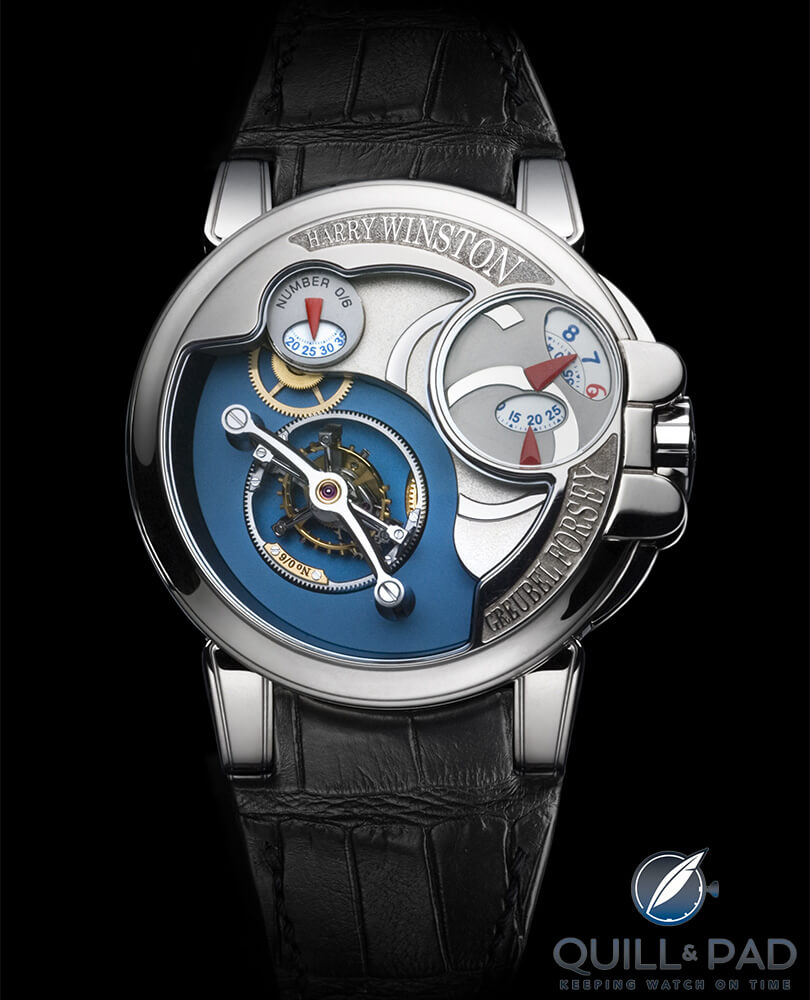
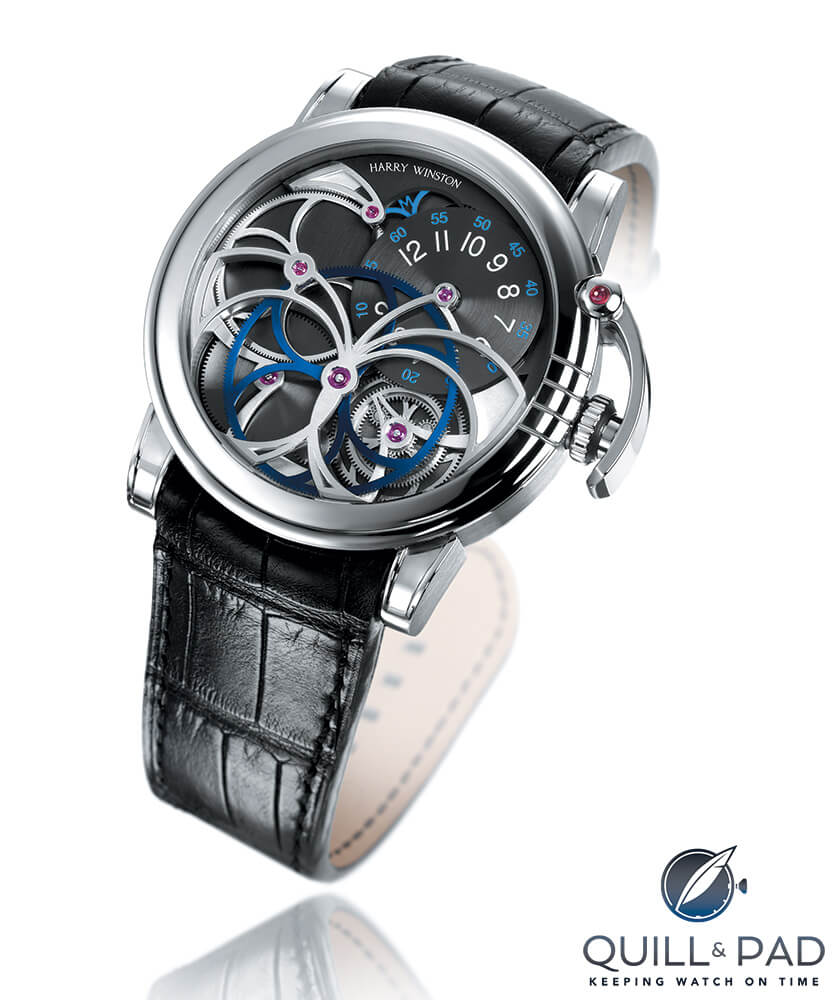
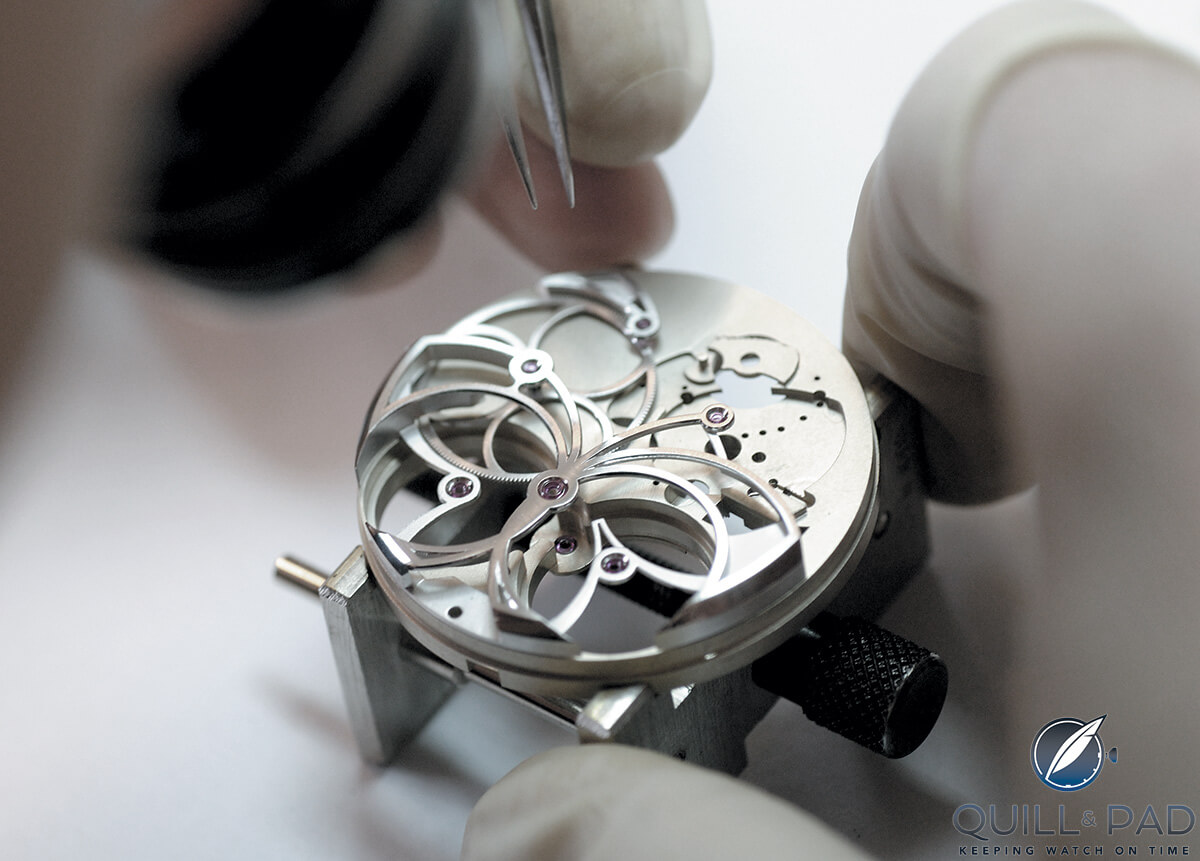
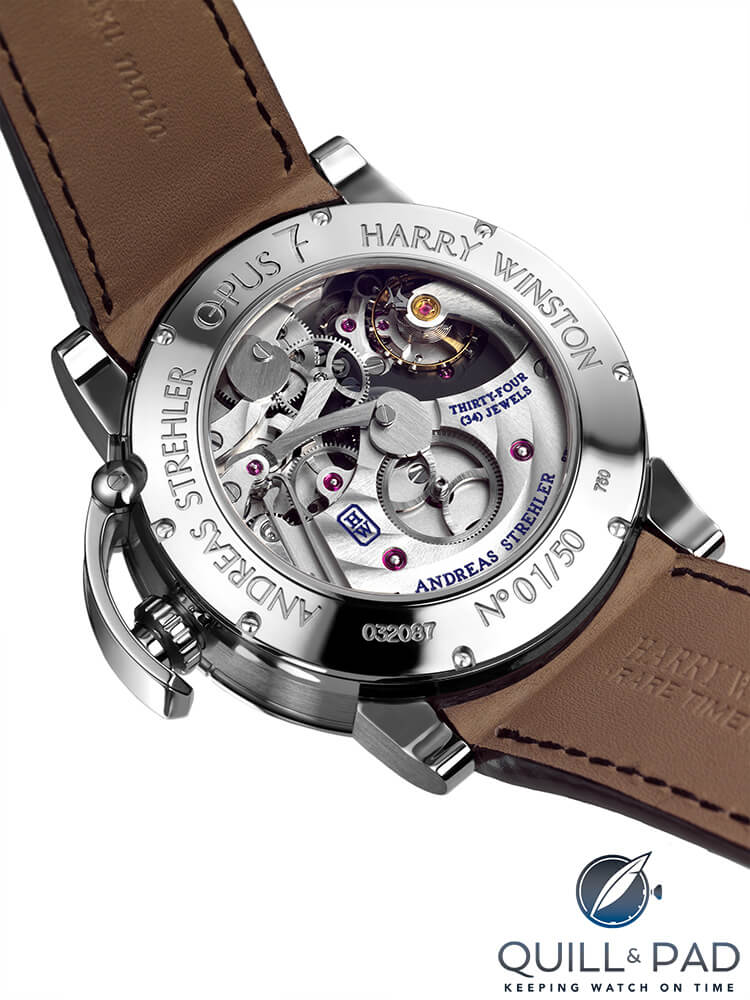
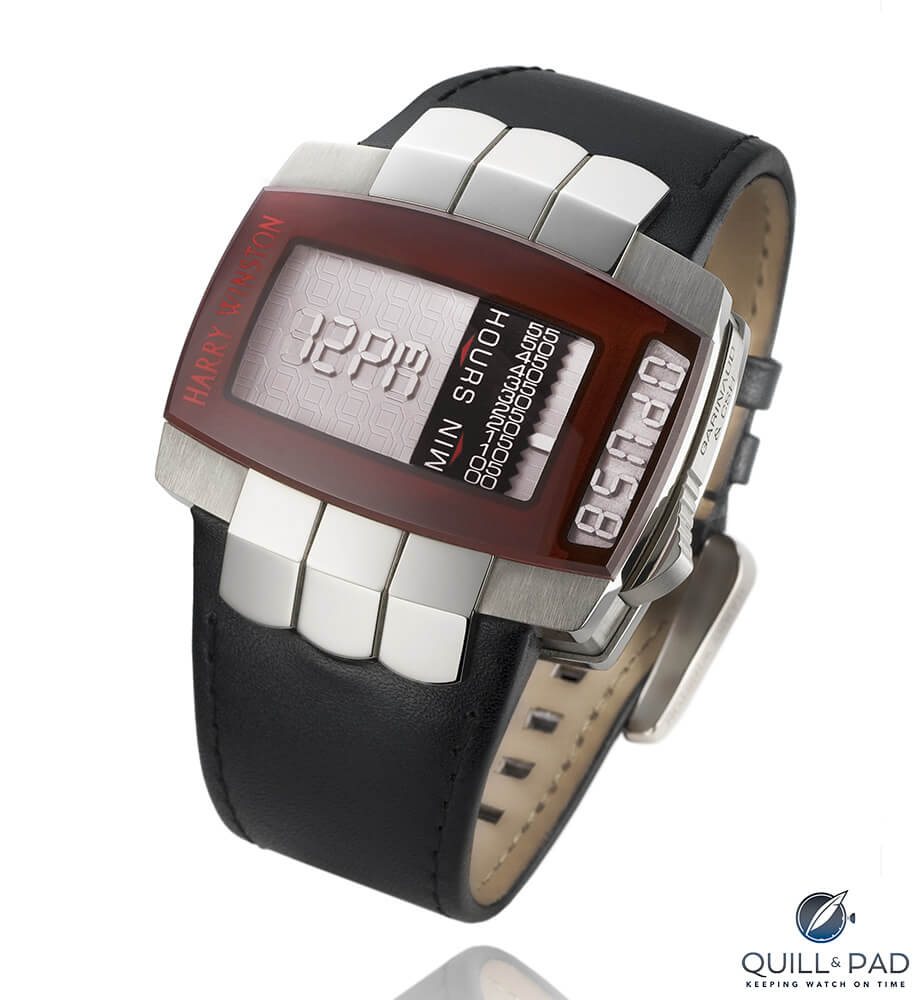
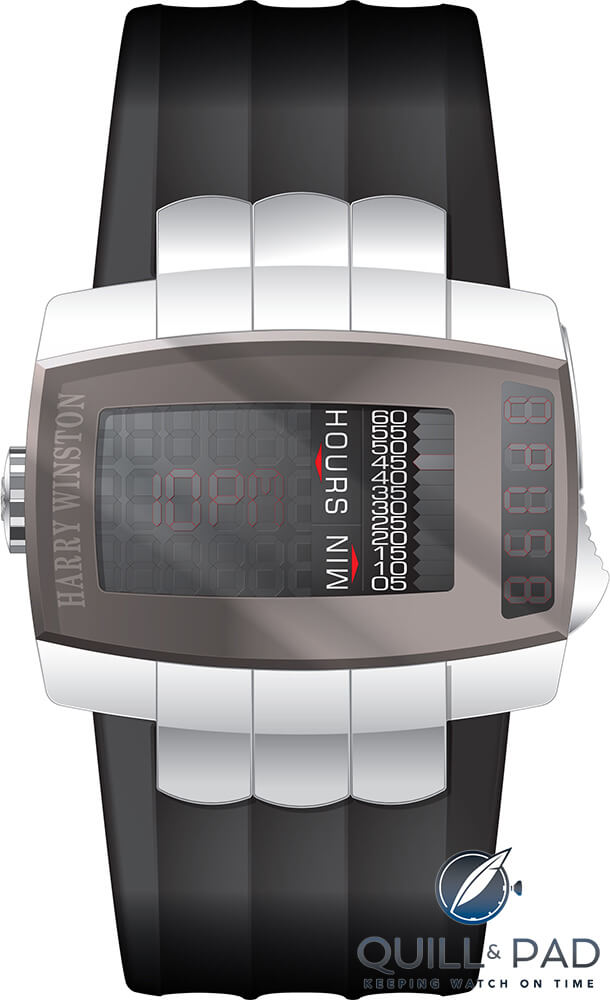
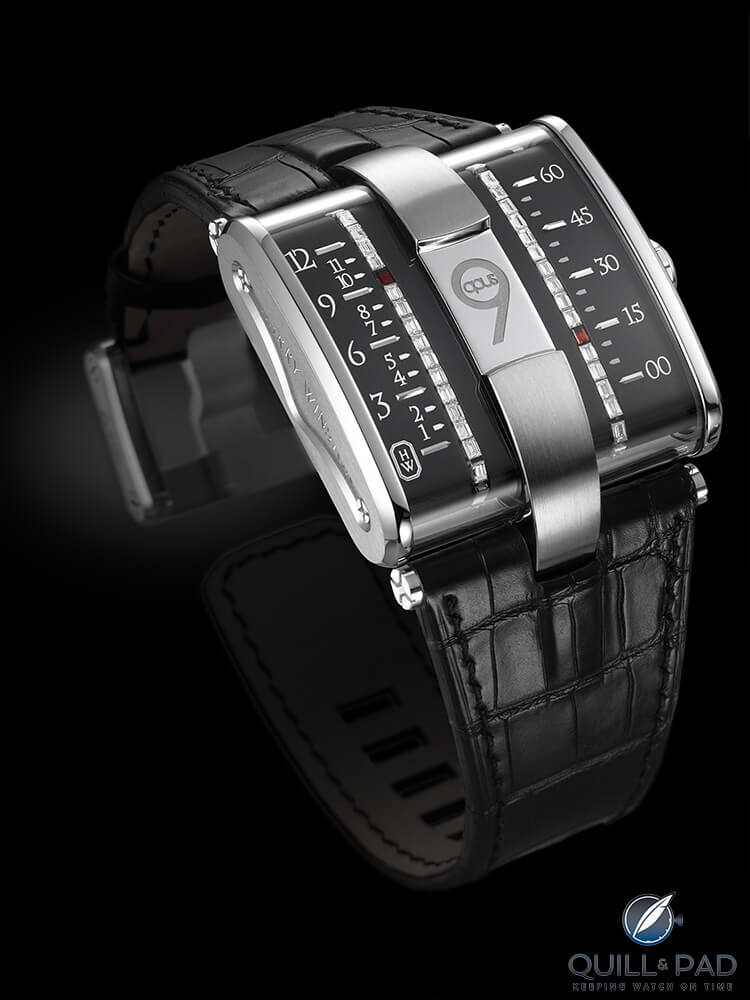
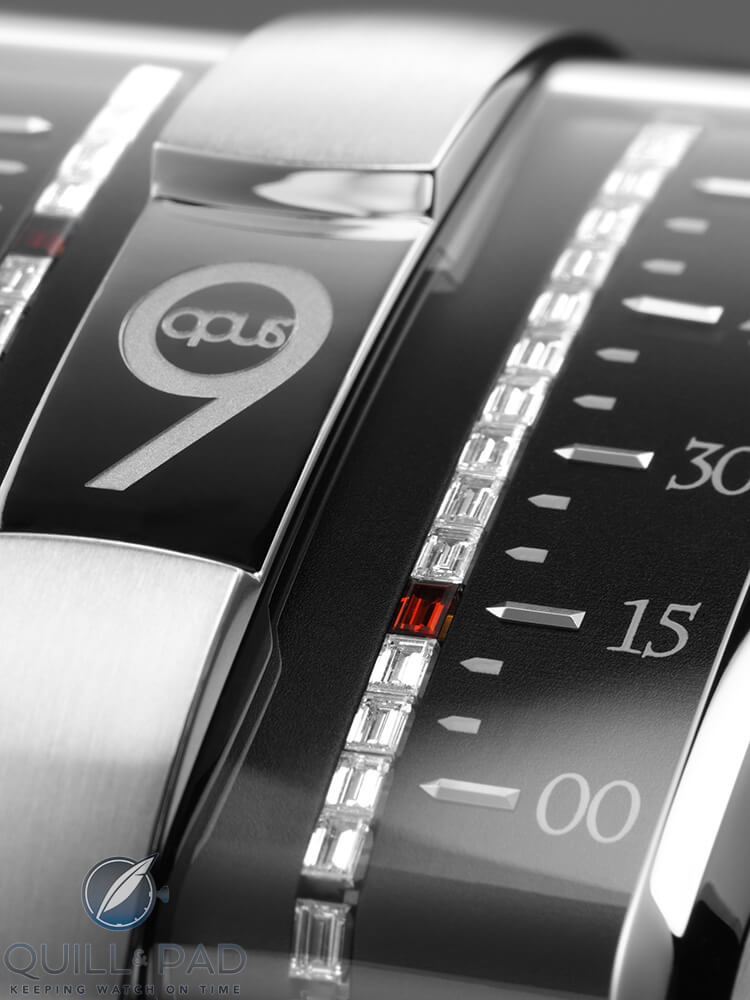
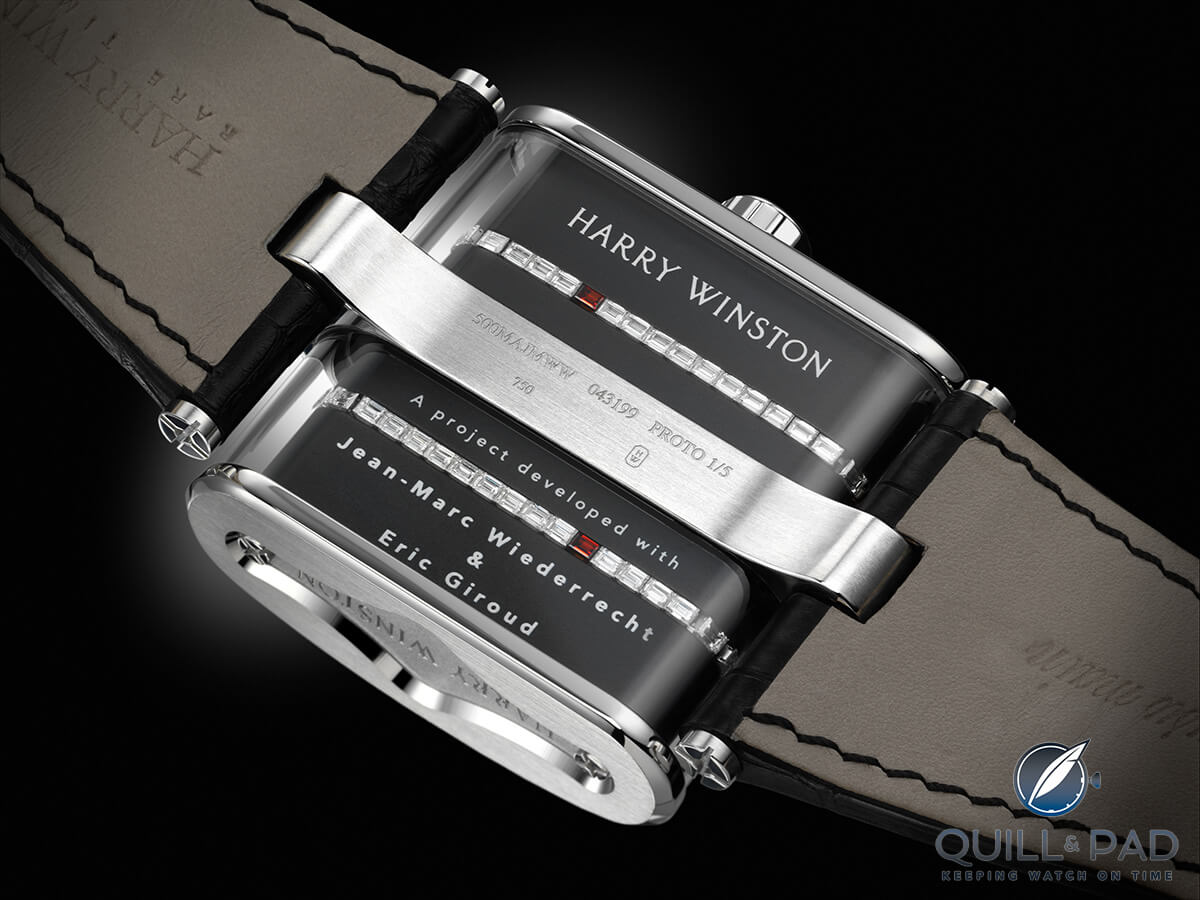
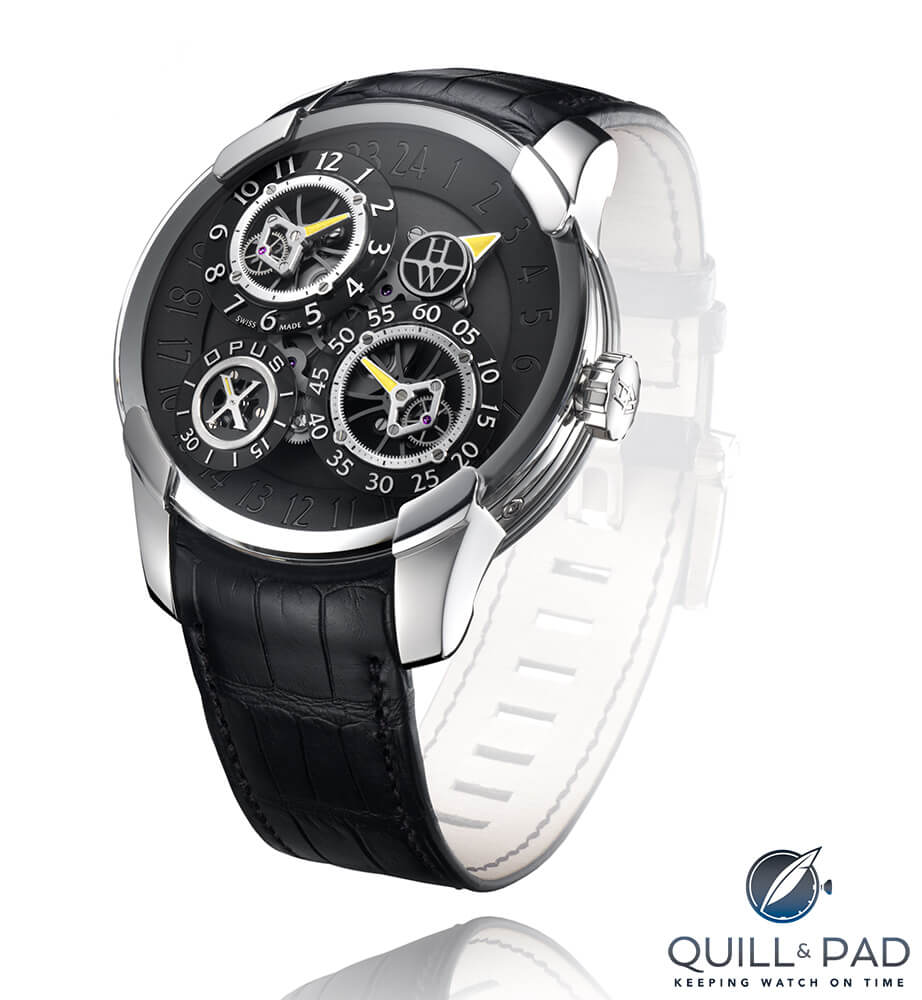
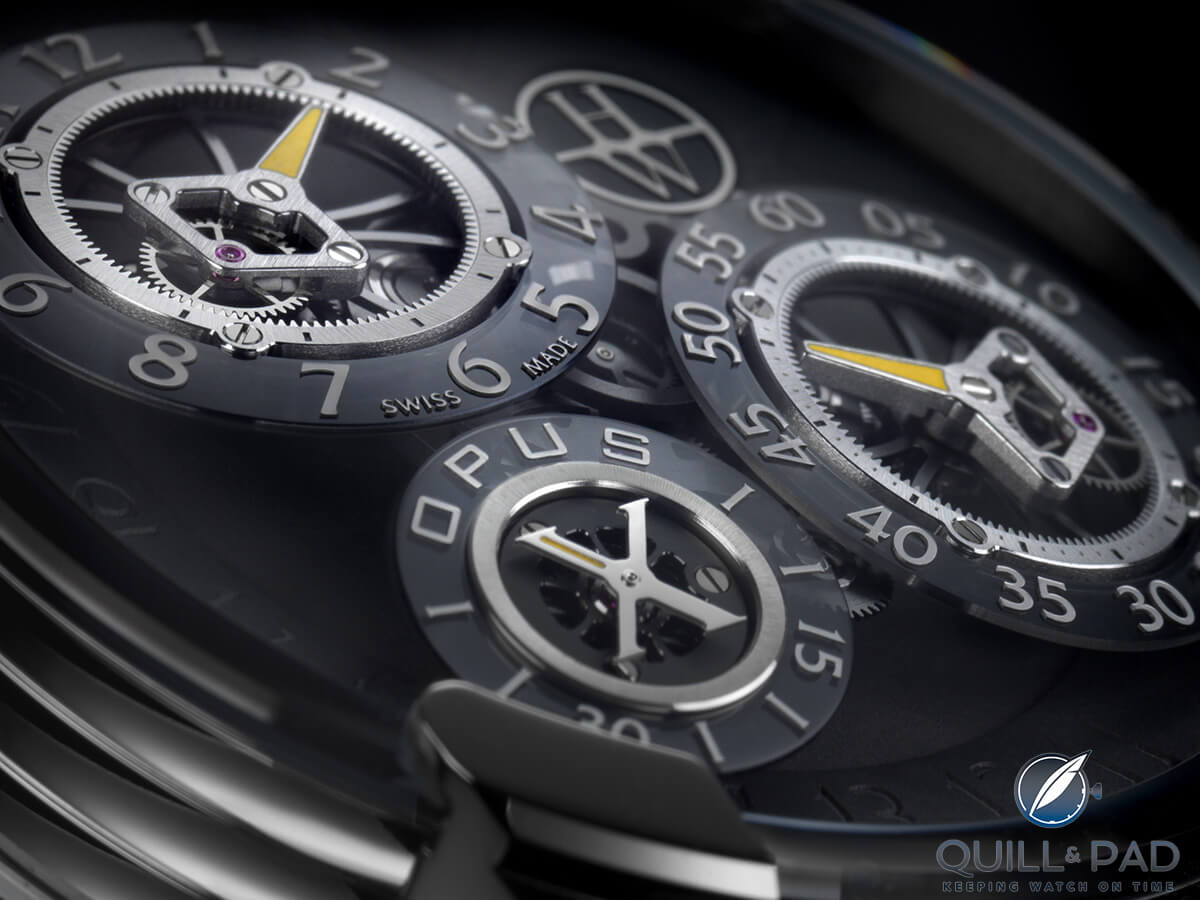
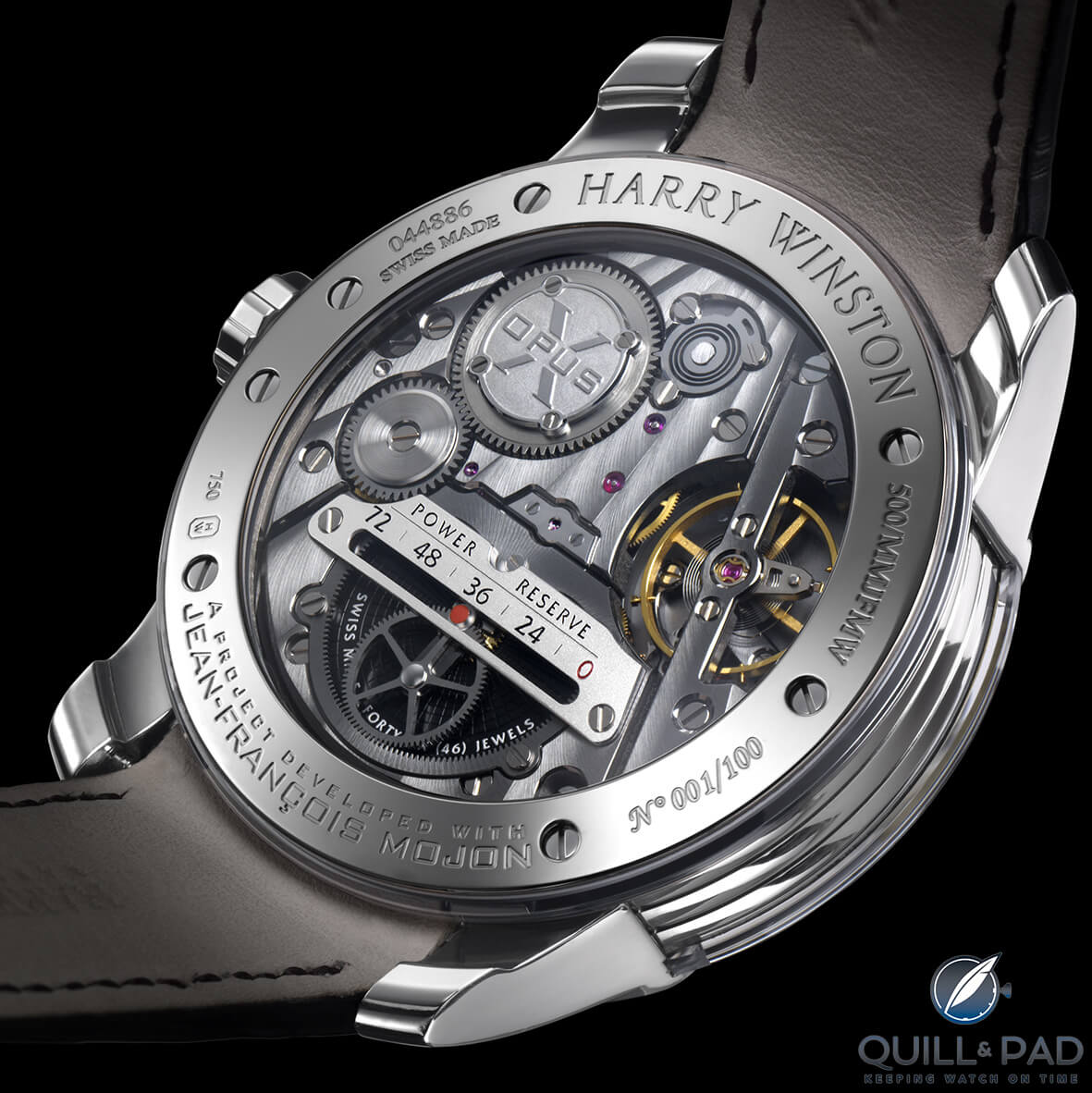

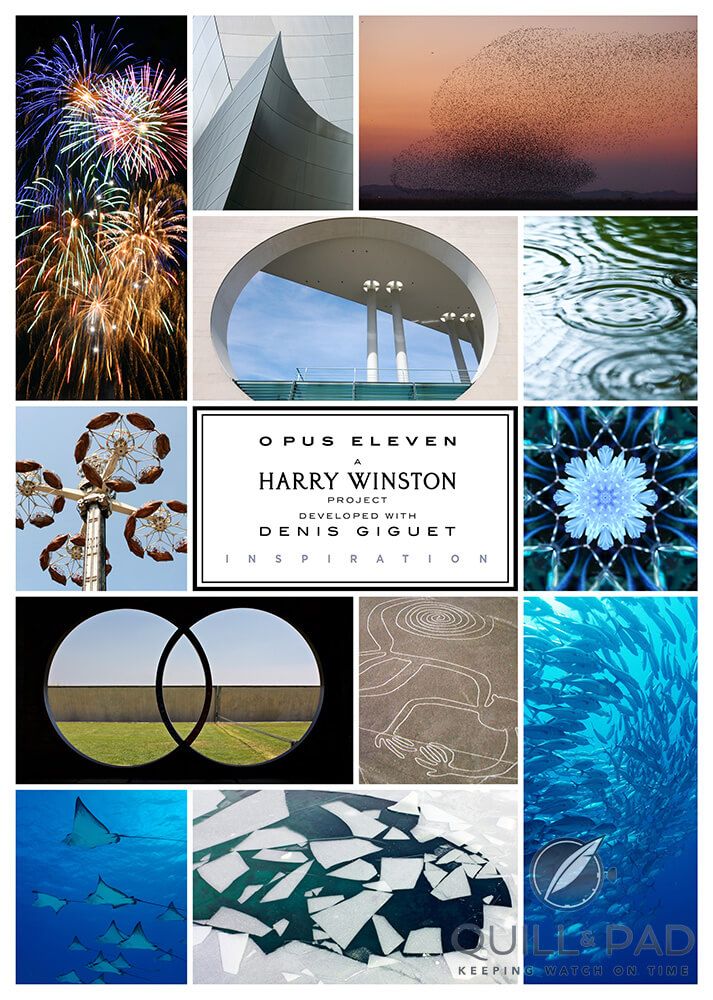
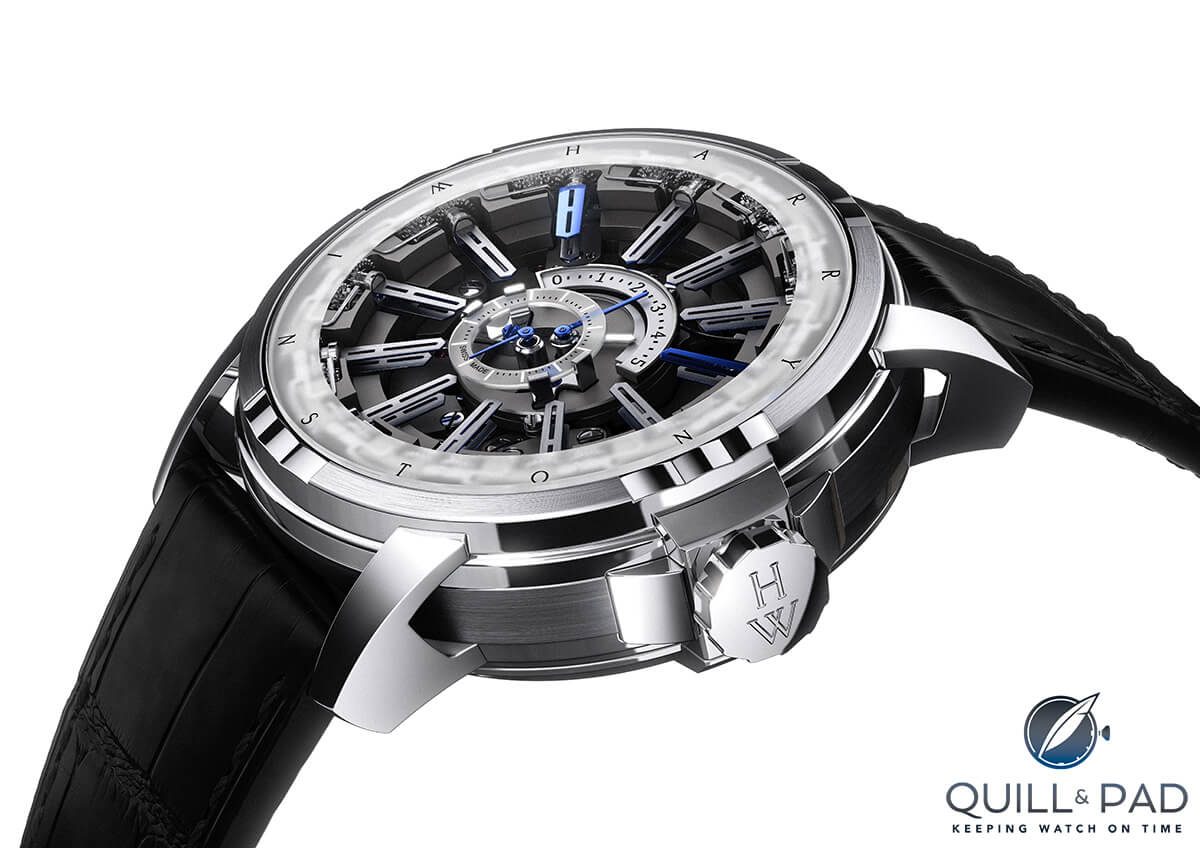
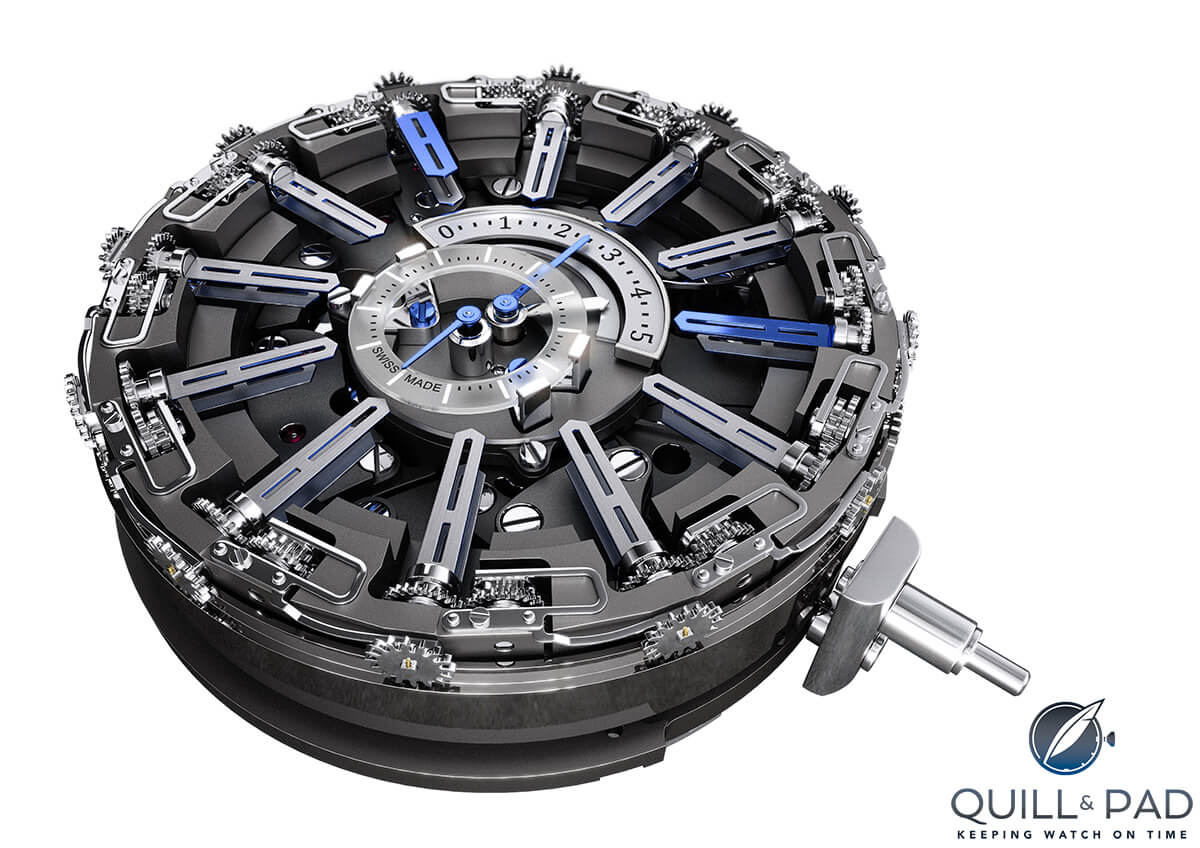
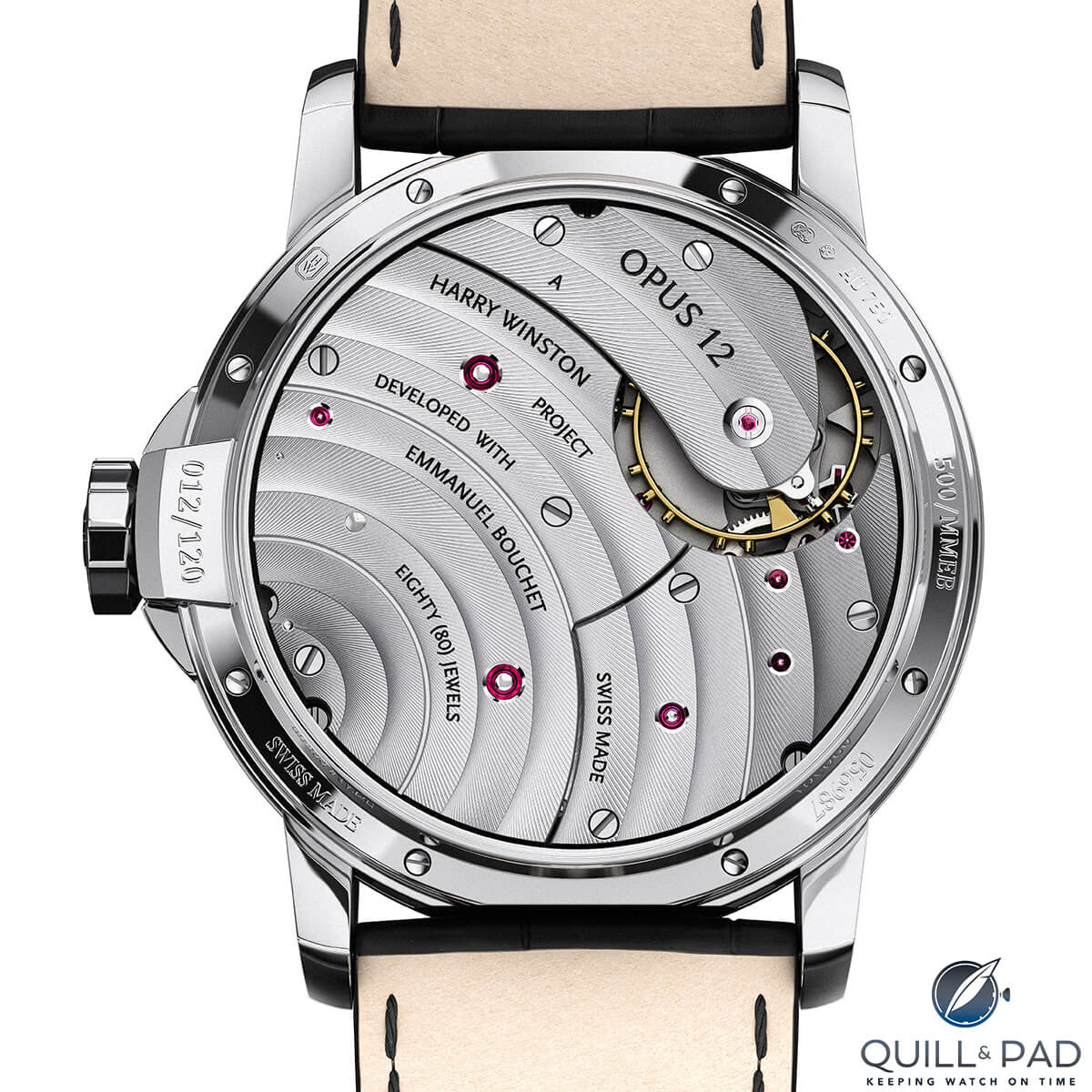
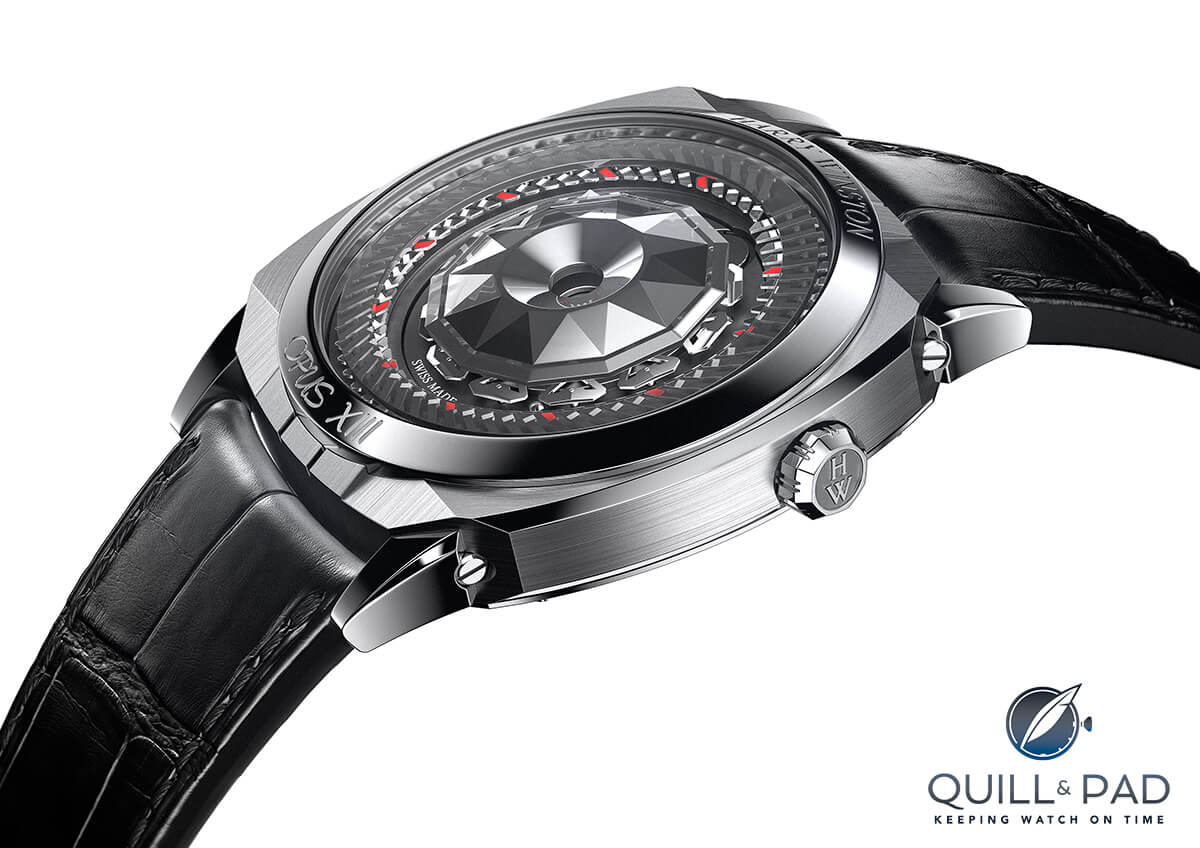
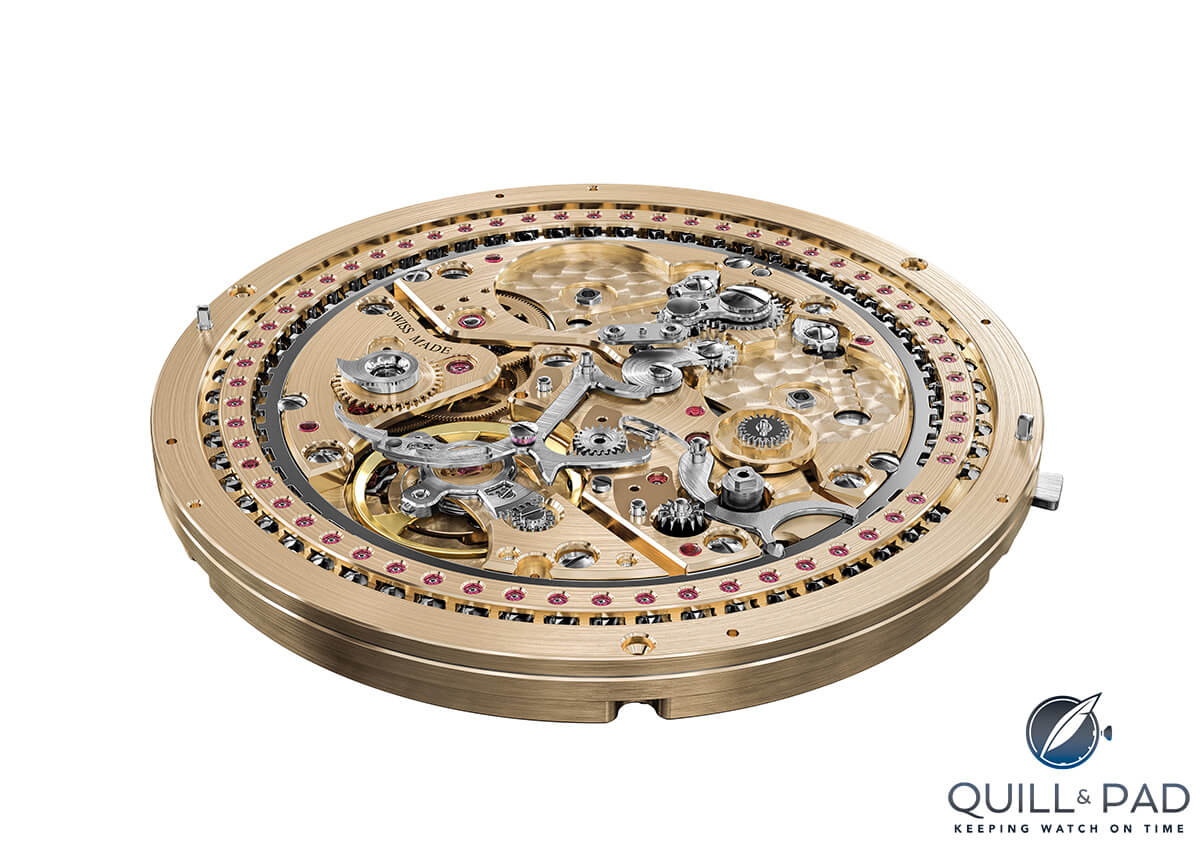
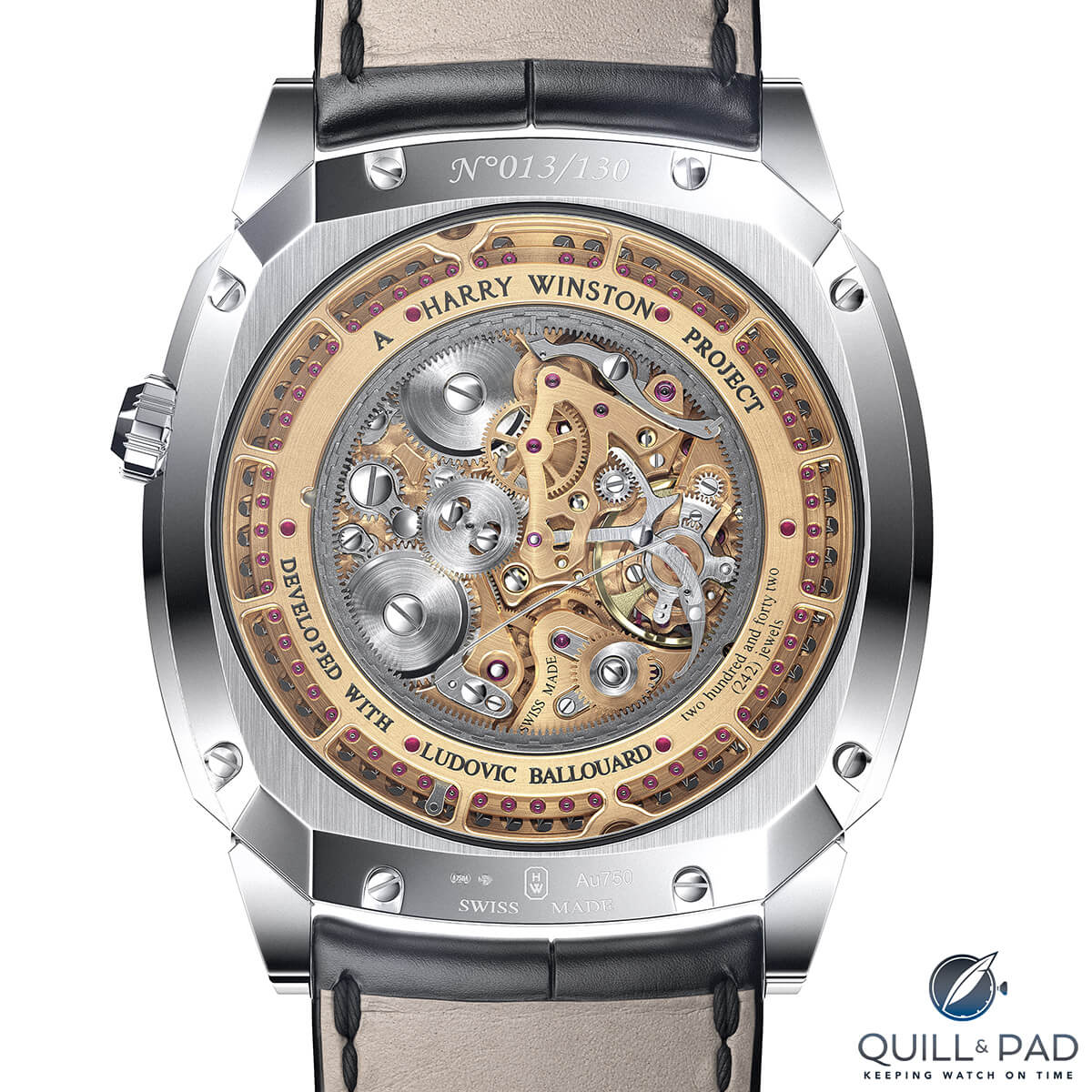


Great article! Well done. That Opus collection takes the cake.
That Opus 14 really humongous, the 2000s era wants it styling back.